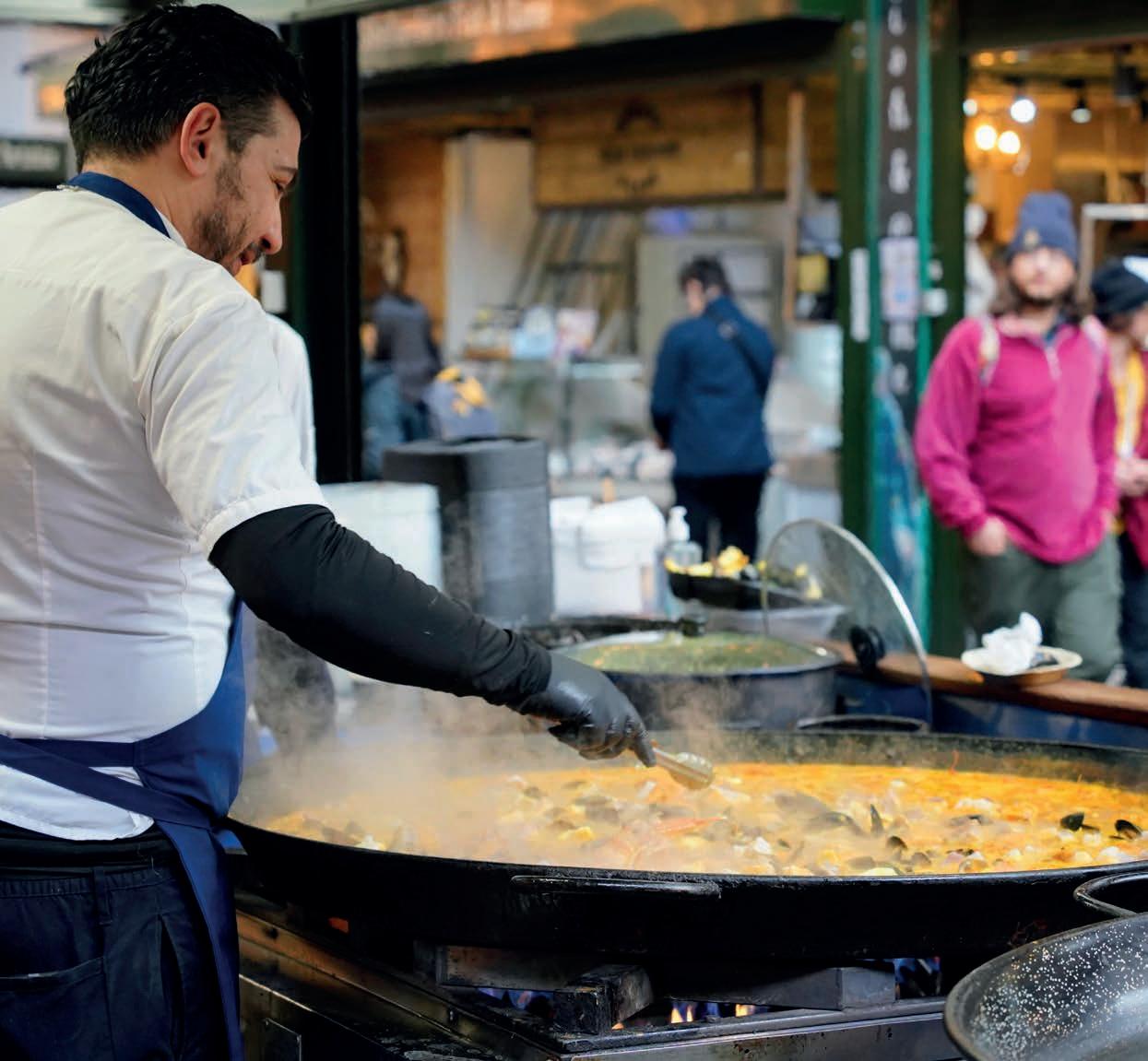

Editor’s comment
Boilers went through a major transformation 20 years ago when the government mandated that all new models sold and installed must be a condensing type. It was a legislative move that improved energy efficiency at a stroke and that has saved £320 per year per household, according to the Energy Saving Trust. It’s thought that 25 million new models have been fitted since 2005.
Yet another fundamental change to the way our homes are heated could be on the way – and it has the potential to have just as big an impact. Heat pumps are here and the government is ramping up its support for them, both with its ‘warm and fuzzy’ TV campaign and by putting more money behind the Boiler Upgrade Scheme. And it seems to be doing the trick: installations are showing a consistent increase.
Energy efficiency and protecting the climate are at the heart of decarbonising heating and hot water. The industry is focused on the UK’s commitment to net zero carbon in 2050, and reaching the government’s target of 600,000 heat pump installations per year in just three years’ time. Demystifying the technology, making legislative changes and providing information to consumers are key to those ambitions – just as they were 20 years ago.
Nicki Shearer, editor
Gas Safe Register, PO Box 631, DARLINGTON, DL1 9GD
Email: enquiries@gassaferegister.co.uk, register@gassaferegister. co.uk or technical@gassaferegister.co.uk
Managing editor: Sue Harker, sue.harker@gassaferegister.co.uk
Editor: Nicki Shearer, editorial@registeredgasengineer.co.uk
News: Jennie Ward, news@registeredgasengineer.co.uk
Publisher: Peter McCreary, publisher@registeredgasengineer.co.uk
Technical consultants: Rob Walkerdine, Jonathan Palmer, Mike Cummings
Production: Mark Turpin
Advertising enquiries only: Ian Carter, ian@rgemagazine.co.uk
Additional print subscriptions £25 per year email: wgardiner@circdata.com, Tel 020 8149 9222
Registered Gas Engineer is written, designed and published by The Team on behalf of Gas Safe Register. 30 Park Street, London, SE1 9EQ
Issue 185 | May/June 2025 The views expressed in this magazine are not necessarily those of Gas Safe Register. The publishers will accept an advertisement or other inserted material only on the condition that the advertiser warrants that such advertisement does not in any way infringe copyright or contravene the provisions of the Trade Descriptions Act. All copy is subject to the approval of the publisher, who reserves the right to refuse, amend, withdraw or otherwise deal with advertisements submitted to it at its absolute discretion and without explanation. All advertisements must comply with the British Code of Advertising Practice. ABC membership approved 19 March, 2009.
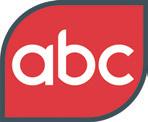
CIRCULATION: Jan-Dec 2024 77,432
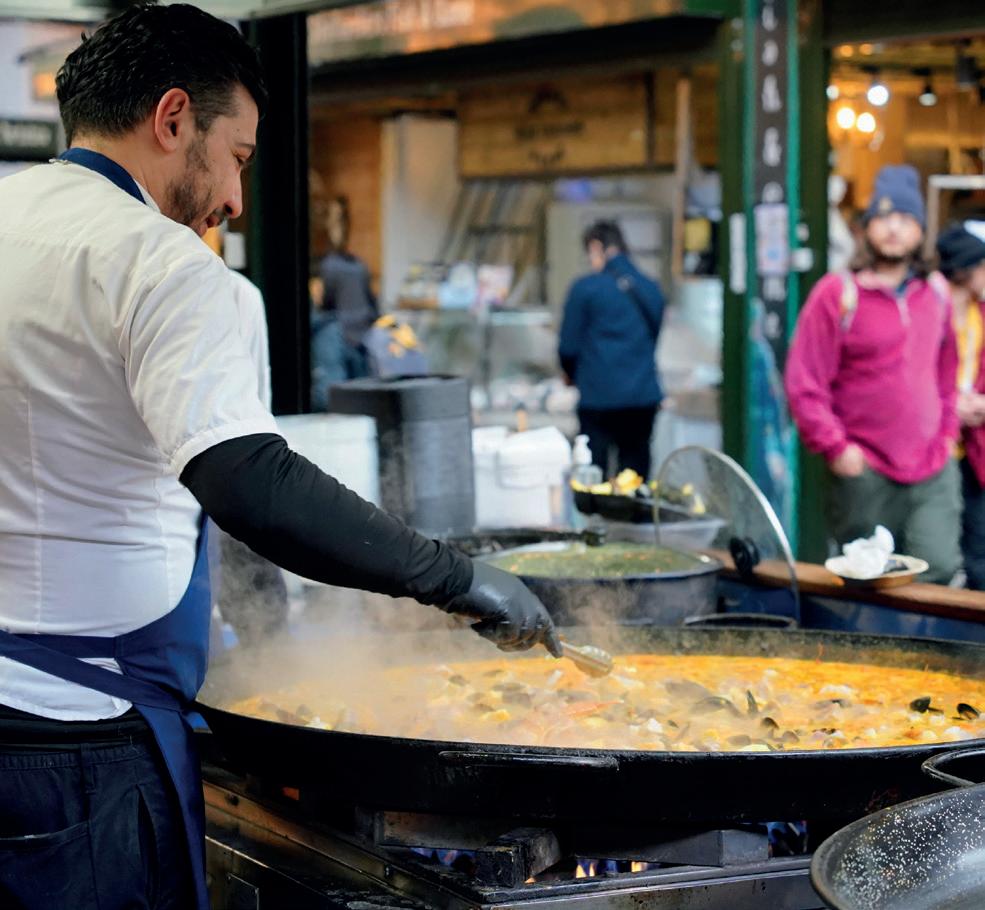
05
Gas Safe Register Update
How the Register’s campaigns supported gas safety through the winter; 2025 registration fees
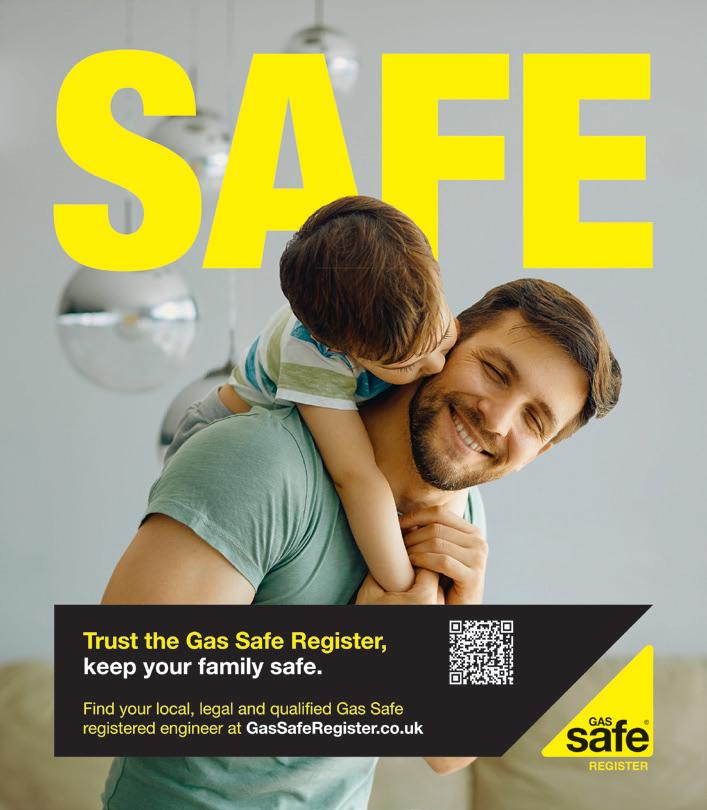
The good, the bad and the ugly
Why it’s important to make sure you choose genuine spare parts when you’re servicing or repairing a boiler – and the potential consequences if you don’t
Are safety checks enough?
Should landlords’ gas safety checks be replaced by full servicing and energy efficiency checks?
Safe handling of non-refillable LPG cylinders
Heat pumps are gaining traction: what’s the latest from the lowcarbon sector of the industry?
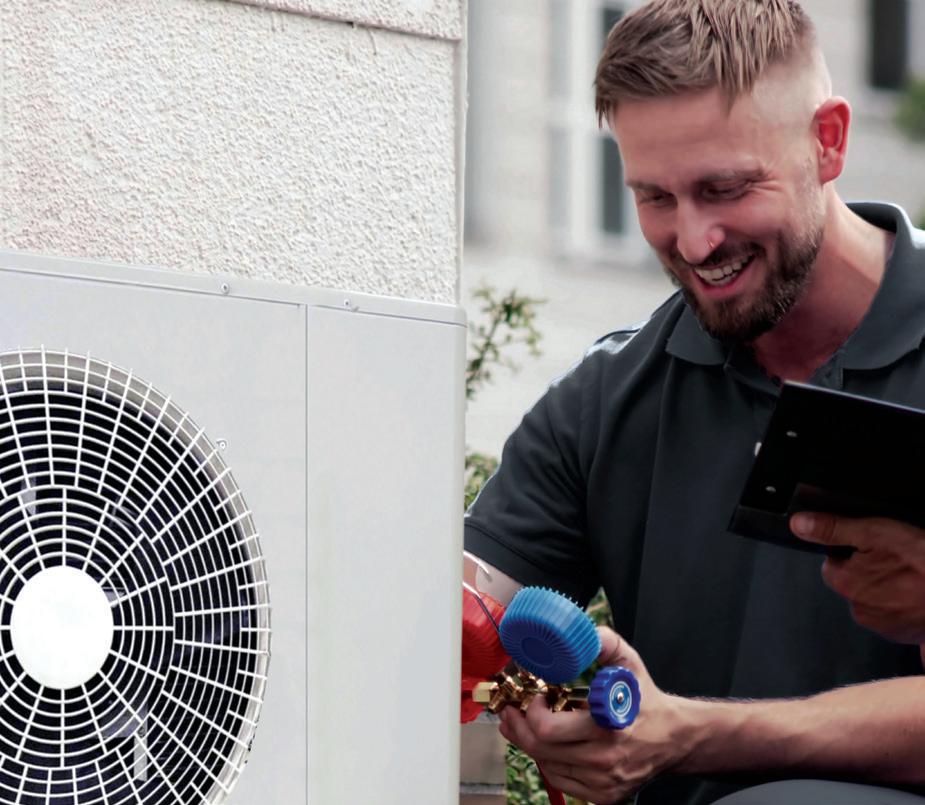
Power up your online presence with generative AI
The latest launches from around the industry
What you need to know about gas safety and outdoor catering as summer gets under way
System corrosion What causes it, how to identify it and how to treat it
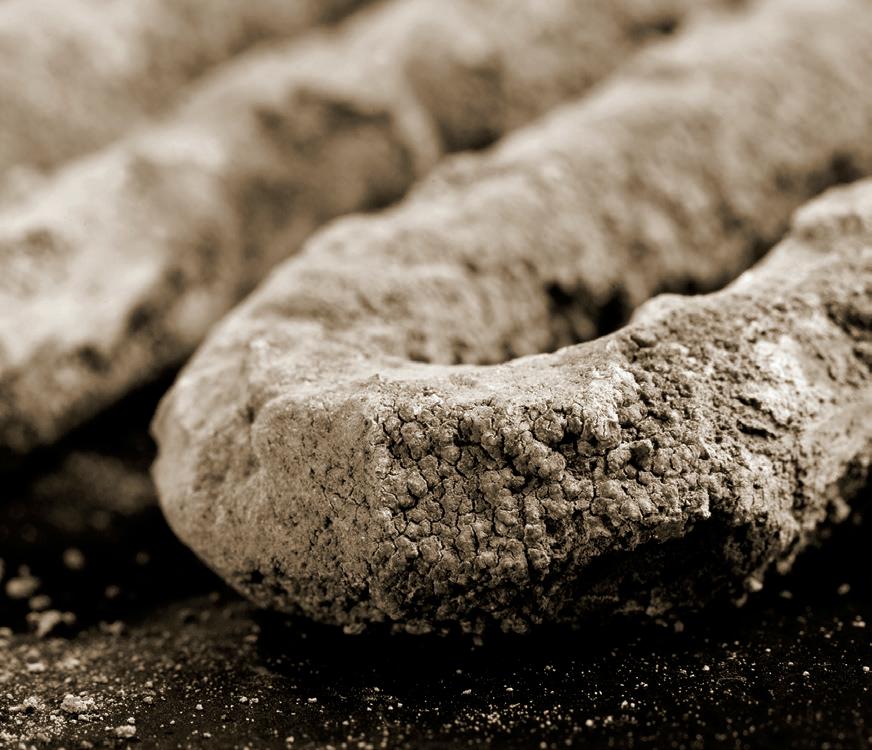
YOU’VE DEDICATED A LIFETIME TO MASTERING YOUR CRAFT. WE’VE DEDICATED OVER 150 YEARS TO SAVING YOU TIME. Our brand new uniSTOR range can save you time, with convenient features for a faster installation. Designed for greater efficiency and performance, with all domestic boilers and heat pump installations. A new cylinder range, built to meet your needs.

PRE-PLUMBED AND INTERNAL AIR GAP OPTIONS FRONT FACING LABELLED CONNECTIONS



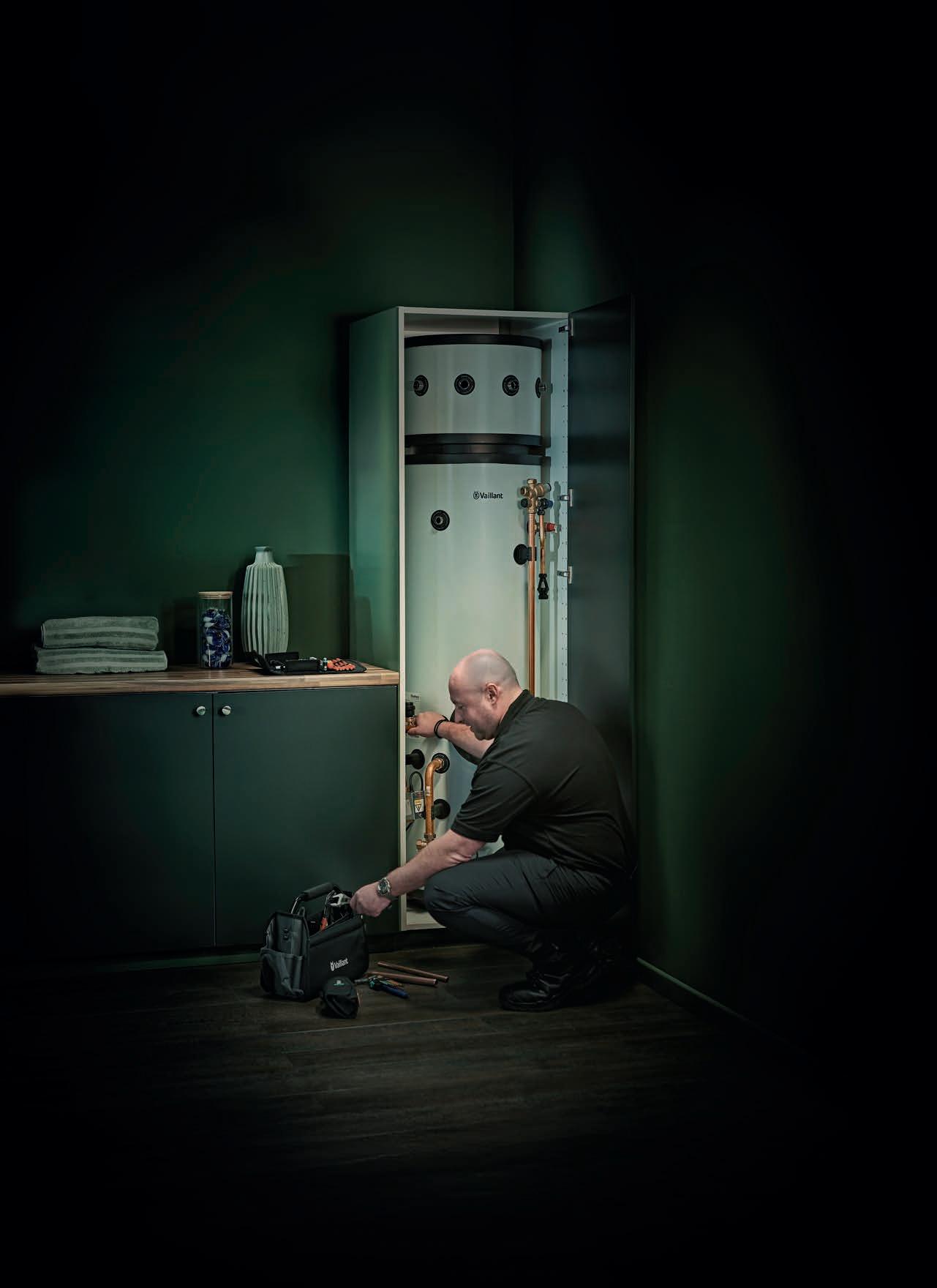

update
from the Register
Winter of safety: the results are in
Gas Safe Register was visible through the winter, warning millions of people about the dangers of carbon monoxide and of using illegal gas fitters.
Marketing started in autumn and ended in midFebruary – coinciding with when most homes use their heating to stay warm and cosy. The Register also ran two major PR campaigns to reinforce its advertising. The first, in November, supported “the big switch on” and the second ran in January, in the depths of winter.
Gas Safe Register reminded the nation to only use a registered engineer to keep their family safe, including their pets. Sharing the ways to spot the symptoms of CO poisoning
Audiences reached
to the UK’s millions of animal-lovers proved an attention-grabbing way to engage consumers.
The Register also reminded Britons how to spot the symptoms of CO and not to mistake some overlapping symptoms with seasonal viruses. Its study revealed that only one-quarter (27%) of respondents recognise symptoms such as
Registration fees from 1 April 2025
headaches, shortness of breath and fatigue as potential signs of CO exposure.
A survey, carried out in December, found that 76% of people would use Gas Safe Register when they need to find or check a gas engineer. But this rose to 88% among those who had seen the ads. Overall, the campaign reached 80% of adults through multiple channels.






































































No
No need to rely on the mystic arts to find the right parts... We’ve got you covered.
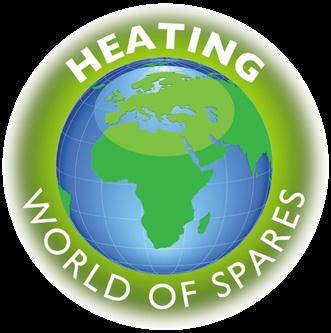
thegoodthebad&theugly
Send us your pictures Registered Gas Engineer wants to see your pictures – whether you’ve come across some horrors or instances of really good work. Please email your stories and pictures to editorial@registeredgasengineer.co.uk
FROM SHAUN WILSON
Shaun’s customer told him they felt dizzy: he found a corroded chimney/flue with an incorrect fall. The boiler was isolated and a new boiler was installed. At a different job (below), the customer reported a delayed ignition sequence and a banging noise. The culprit was a balanced flue heater with a rotted chimney/flue. Shaun isolated the installation and replaced it.
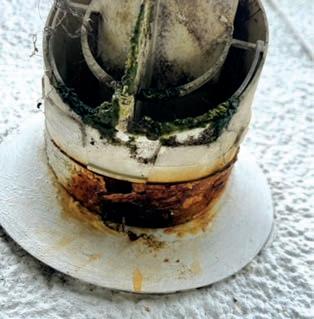
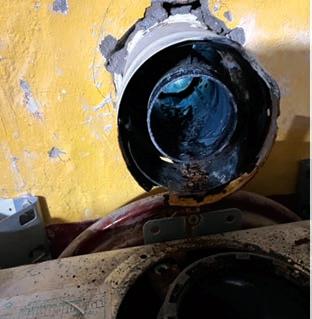
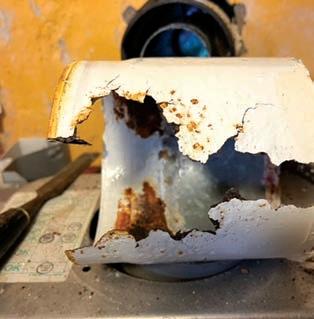
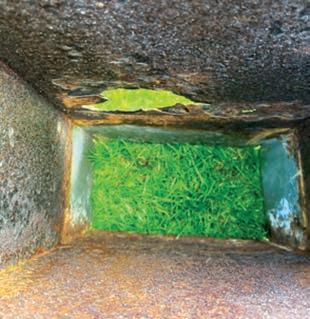
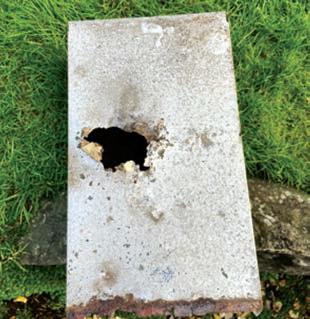
FROM MARK MAESTRI
A gas engineer had reported high CO levels. When Mark investigated, he noticed that the roof had been jet-washed and repointed – and the builder had left their beanie hat on the chimney/flue terminal.
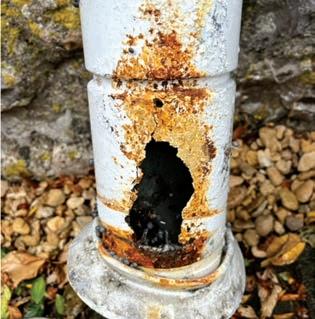
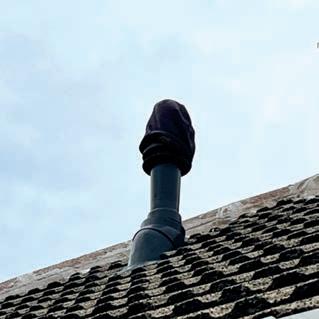
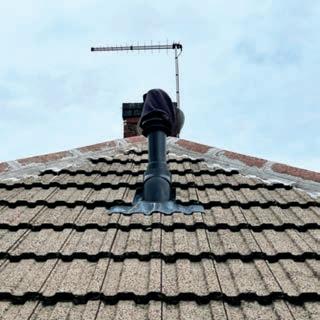
thegoodthebad&theugly
FROM RAWSON BREARLEYSWAINE
Here are some real boiler horrors from a holiday in Rome, where it seems almost as though they are designed to hang in mid-air. Don’t try this at home!
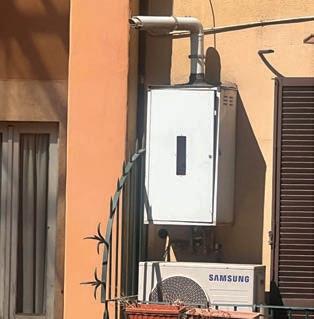
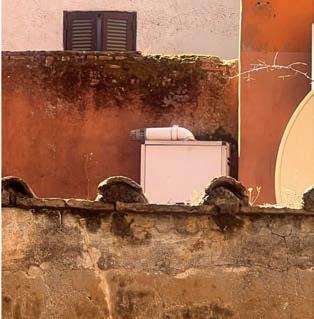
FROM ARTON PLUMBING AND HEATING
When the boiler is old and needs attention, the chances are that the flue does too.
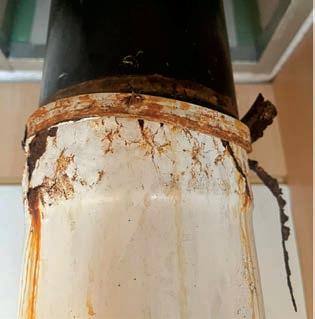
FROM TONY TULLEY
Tony had been called to carry out a powerflush at property but, on inspection, he found the flue completely eroded. He replaced it and added a plume kit.
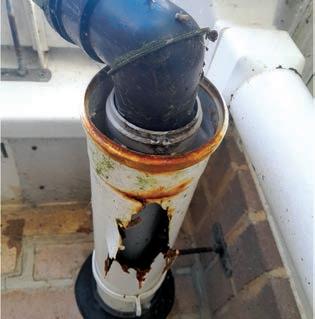
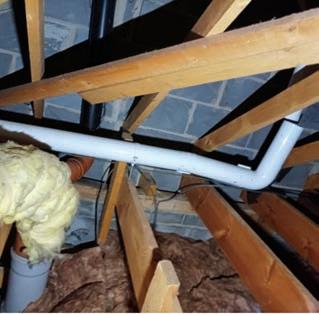
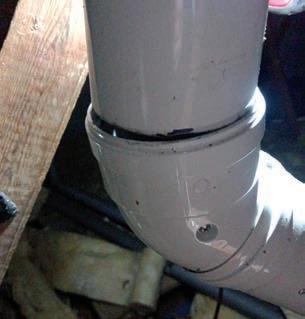
FROM PHILIP MCCARTHY
Missing flue clips have been a theme for Philip lately. The top photo shows that the fitting had slipped off due to a lack of clips, while the second flue had somehow passed an integrity test – which proves the importance of visual checks.
We may share some of your pictures on social media, so remember to include your contact details so we can tag you (or let us know if you’d rather we didn’t).
025-W
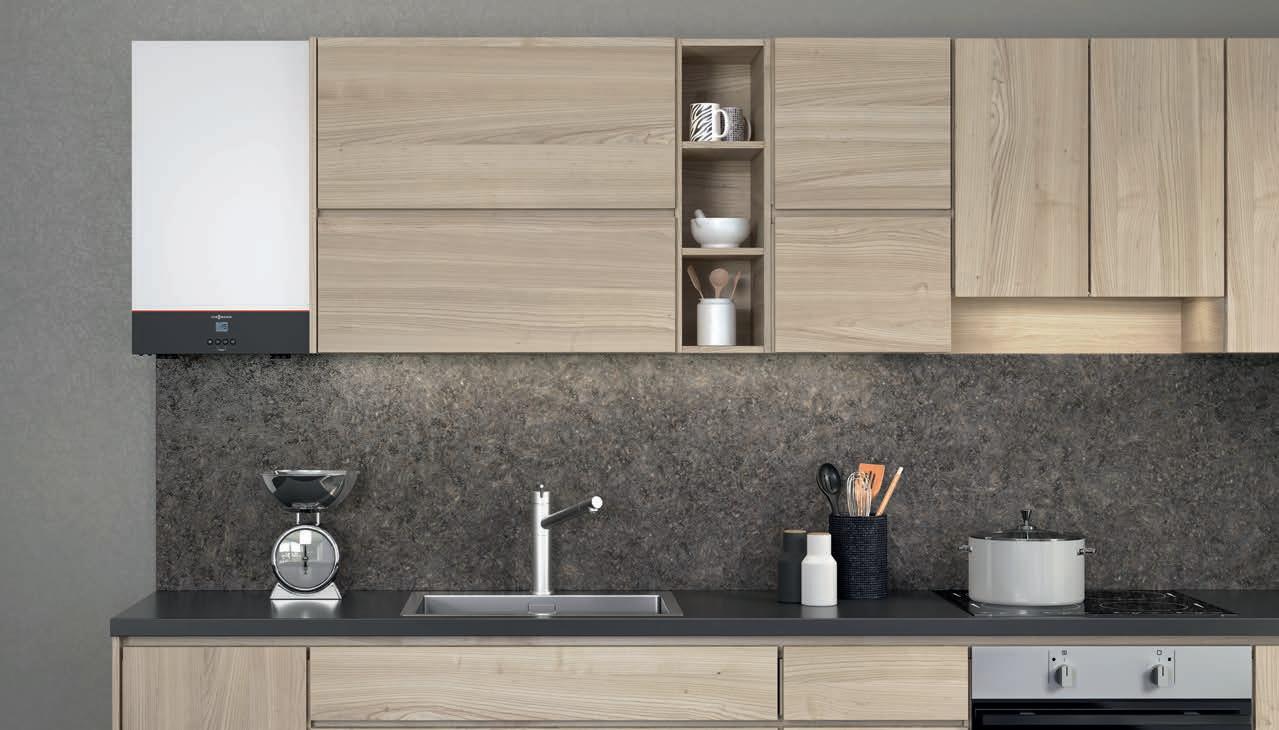
Introducing the brand new Vitodens 025-W combi wall mounted boiler
+ 24 and 28 kW sizes
+ Inox-Radial stainless steel heat exchanger
+ Low operating noise, compact dimensions
+ 5 year boiler warranty
+ 10 year heat exchanger warranty
+ Pre-commissioned
Find out more

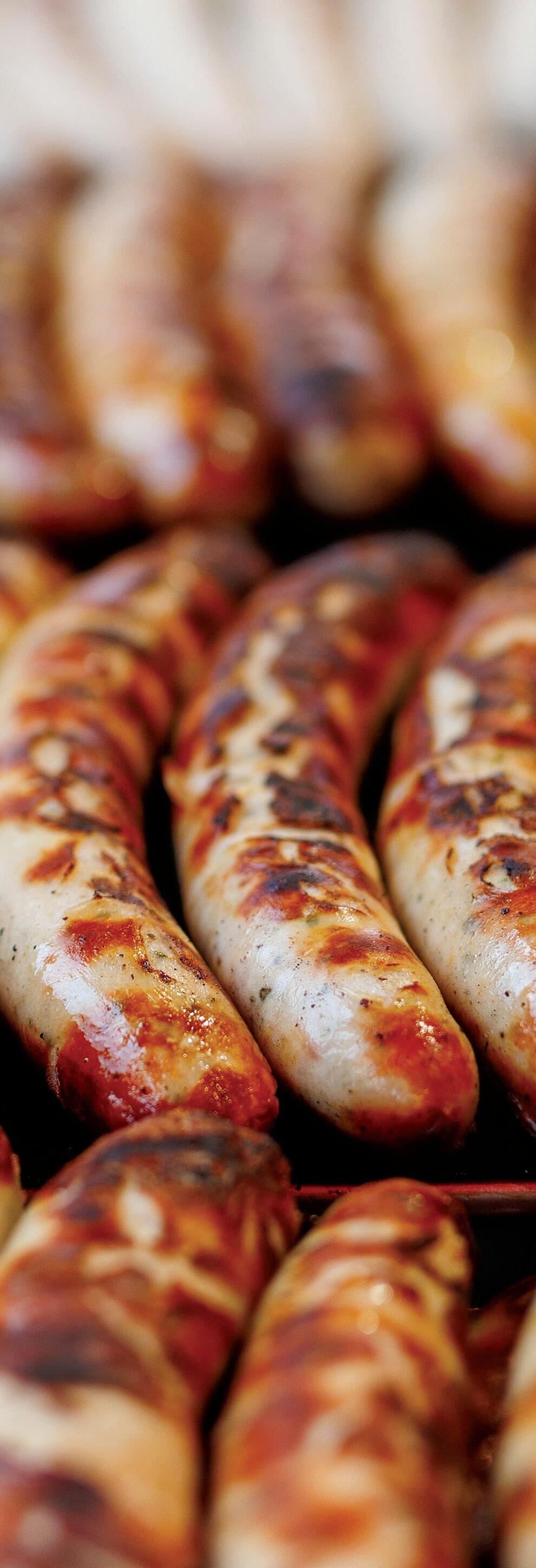
Gas safety and outdoor catering
With summer on the way, festivals and outdoor events will be springing up all over the country – and many hot food outlets will be using LPG. What should gas engineers who work in this specialist field look out for and know?
What are the requirements?
When it comes to outdoor events, organisers have to confirm which vendors will be attending and whether they will be using LPG. The organisers must obtain the relevant gas safety certificates and provide them to the local authority, which checks the details of the registered engineer who carried them out and ensures that they’re registered, competent and working within scope.
An environmental health officer checks that the owner is using the equipment for the purpose stated, and that the equipment in situ will be used as originally indicated.
When gas engineers see something that concerns them, they should bring it to the attention of their local authority environment health officer.
What to look out for
Food catering inside tents and gazebos brings its own challenges, not only because of the risk of carbon monoxide from inadequate ventilation but from burners that are too close to the sides. To avoid accidental ignition, appliances should be sited at least 600mm from flammable materials such as a tent/gazebo canvas and screens.
Units in a gas daisy chain that cook food – such as paella dishes on large open pans –can cause pressure drops, with the risk that the flame will go out and gas will leak. When pans are set up incorrectly, the food will be at different temperatures, with those farthest away being colder. All burners should be protected by flame supervision devices.
It’s also important that people working inside know what they should do with the gas equipment if there’s an emergency.
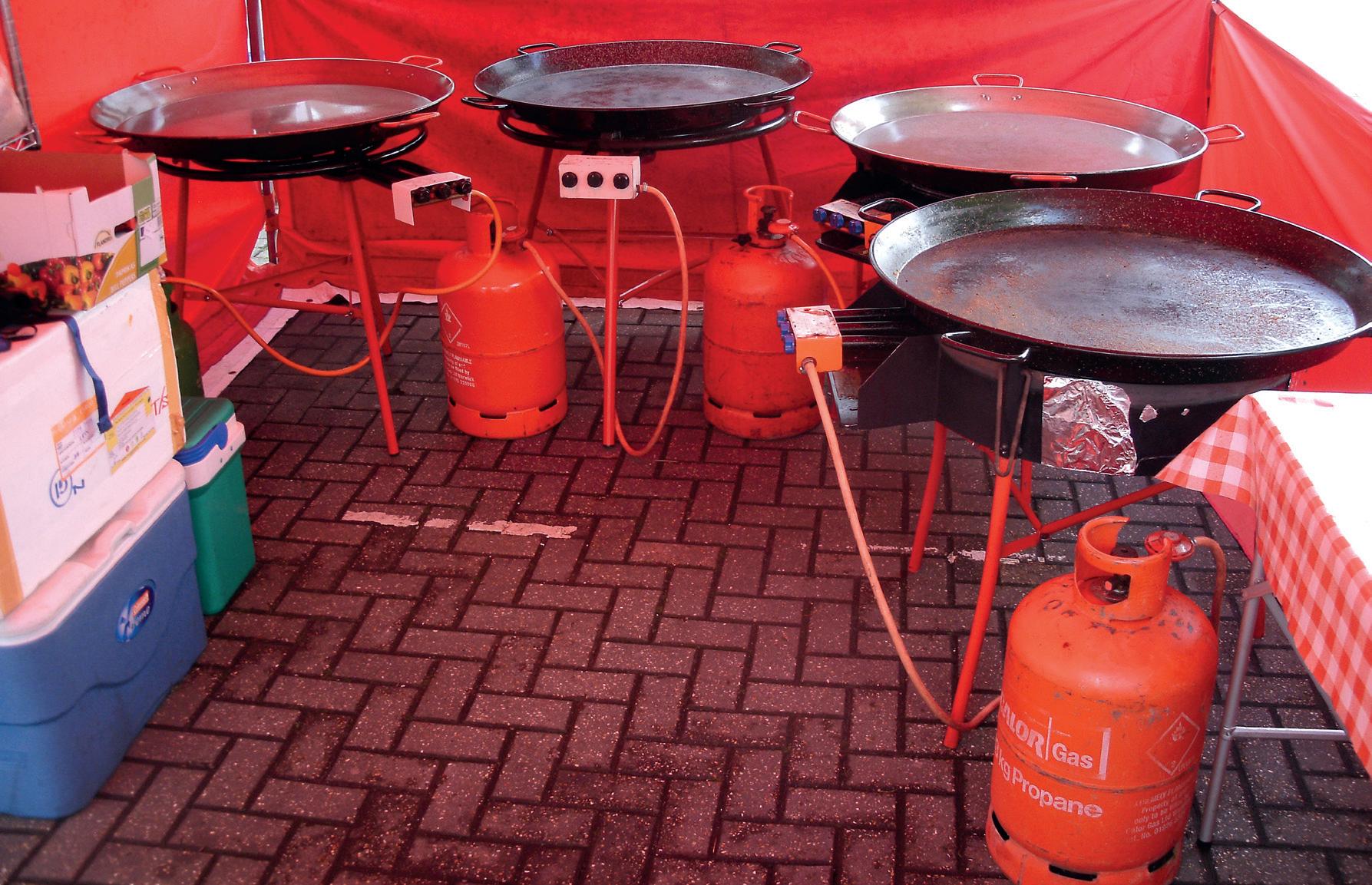
Maintenance
Gas appliances must be maintained in a safe condition. It is recommended that servicing is carried out in accordance with the manufacturer’s instructions, at least every 12 months. Where appliances are used frequently, servicing every six months should be considered.
All maintenance work must only be undertaken by a registered gas engineer with the appropriate mobile catering qualifications. Following any work to a gas fitting or appliance, you must carry out checks in line with the Gas Safety (Installation & Use) Regulations (GSIUR) and record the results on your report.
Flexible hoses should be examined regularly for damage or wear and tear and replaced as necessary.
Storage
As with all LPG installations, cylinders should always be stored outdoors in a wellventilated area, above ground
level in an upright position and have a minimum clearance of 1m from any sources of heat, sources of ignition, re-entry points into the area and from combustible or ignitable materials.
The storage area should be flat and level without any unventilated cavities and a minimum of 2m away from any untrapped drains or gullies. This distance can be reduced to 1m if there is an unperforated
Qualifications
diversion wall not less than 250mm high.
Cylinder compartments must be adequately ventilated through the access door at high and low level (not under) directly to outside. Each vent should not be less than 1 per cent of the compartment floor area. These vents must be provided in addition to windows and doors. Screens need to be used to prevent access by pests. They should
The gas qualification for working in commercial mobile catering is a specific one that covers the pipework and cylinder installation. Depending on the catering equipment you work on, additional appliance qualifications are COMCAT 1-5.
If you already hold a core gas qualification such as CCN1 (core domestic gas) or COCN1 (commercial heating), you will need to take CODC1 (domestic NG core to catering core changeover) and COCATA1 (domestic NG appliances to catering appliance changeover – equivalent to COMCAT 1-3) plus CoNGLPG1 CMC1 (changeover from NG to LPG mobile catering units) with COMCAT 2, 4 & 5 if needed – depending on the catering appliances you plan to work on.
If you are a commercial catering engineer with CCCN1 and COMCAT 1-5, you will need CONGLP1 CMC (changeover from NG to LPG mobile catering units).
Paella pans set up incorrectly. Photo credit: Mark Jewell
The requirements for catering appliances
Boiling rings: shall be fitted with flame supervision devices and suitable gas taps for isolation and control.
Fryers and fish & chip ranges: shall have a canopy or ventilation hood fitted, incorporating a flue to the outside air unless the total fume emissions are such that vehicle trailer ventilation design guarantees adequate removal to sustain a safe working environment.
They need a non-adjustable overheat thermostat that will shut off the main burner if the temperature of fat or
be accessible for inspection and cleaning and should be of sufficient gauge to minimise the build-up of dust and dirt.
Access to the cylinder compartments should be from outside. They should be designed to allow easy access for changing cylinders and for their quick removal in an emergency.
Compartments must not be blocked with rubbish or other items and must always be stored with valves uppermost so that only vapour will be withdrawn in use.
Cylinders not in use should be capped or plugged and be returned to the supplier or the event central storage facility when no longer in use.
“Cylinders not in use should be capped or plugged.”
oil exceeds 230°C. Manual resetting of the gas supply should be required and the device should operate independently of the automatic temperature control gas valve. A control thermostat should be fitted to prevent the maximum temperature of oil or fat exceeding 205°C.
Counter-top low-volume fryers shall be risk-assessed to determine whether a canopy is required.
Grillers and toasters: where a pilot burner is incorporated, they shall be fitted with a flame supervision device.
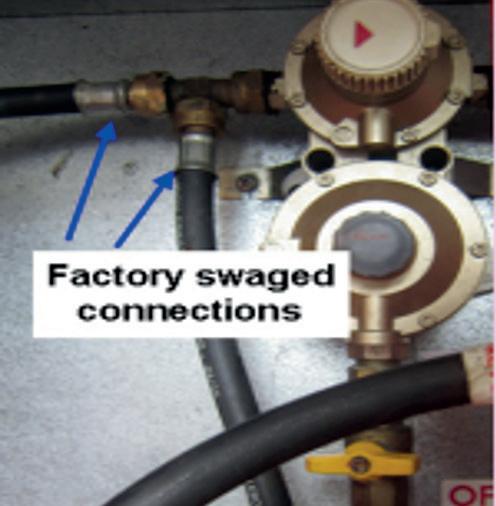
Check the connections
Over-pressure shut-off protection
All regulators and changeover devices shall have overpressure shut-off protection (OPSO) to protect the downstream pipework and appliances from a maximum incidental pressure greater than that for which they are designed.
Portable and outdoor appliances with pre-installed regulators and hose supplied by the manufacturer, with heat input of 1.5kg/h (21kW) or less, may have no OPSO fitted and shall only be connected to a single cylinder. Operation shall be in accordance with the appliance manufacturer’s instructions, with consideration to the location of use and
Bain maries: require a flame supervision device whether they are open well or a fitted container.
Barbecues: and other single appliances supplied by a single cylinder should have a hose length not exceeding 1.5m, and shall be sited and used in accordance with the manufacturer’s instructions.
Other appliances: such as tea urns, water boilers, griddle plates, etc, must have a flame supervision device fitted.
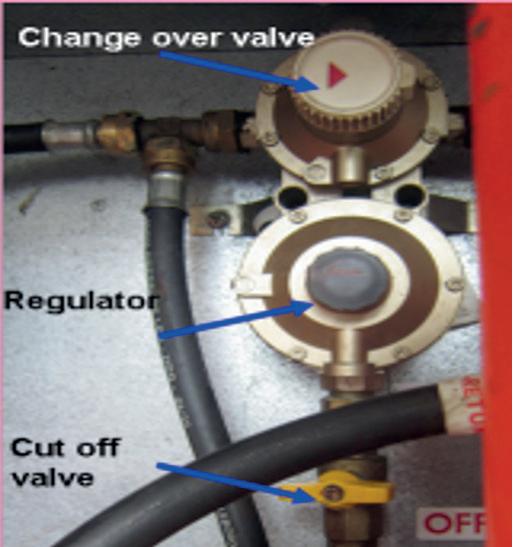
ventilation requirements.
Pressure regulators and safety devices incorporating full vent relief valves must not be used. Where changeover devices are used, non-return valves at the high-pressure inlet need to be incorporated to prevent gas discharging when changing cylinders. Automatic changeover devices shall have an indicator to show when the reserve cylinder is in use and whether it has exhausted the service cylinder.
Regulators shall be securely fitted in accordance with the manufacturer’s instructions. This can include purposemade portable cylinder stand assemblies, ensuring that the regulator is fitted in the
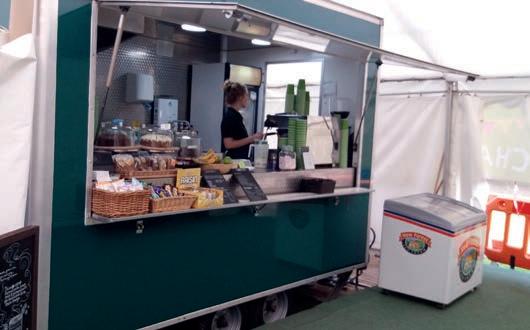
correct position. High-capacity regulator installations using more than 12kg/h (167kW) must be fitted with an emergency control valve (ECV).
Cylinders will normally consist of one or more banks of cylinders that must be adequately segregated and
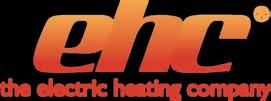
secured to prevent access by the general public.
Any appliance provided for mobile or temporary catering shall be suitable for the purpose for which it is intended. All parts and accessories necessary for its correct operation should be present.
LPG appliances must be approved by the manufacturer for use with propane or butane as appropriate and should conform to the relevant British Standard. If they were manufactured after 1 January 1996, they must carry a CE mark.
Ventilation
In mobile units, free ventilation should be provided at a rate of at least 250mm2 for each kW input rating of all appliances, or 1000mm2, whichever is the greater. This should be divided equally between ventilation openings at high and low level. However, there may be no requirement for additional ventilation if there is a serving hatch that is interlocked with the gas supply so that appliances may not be used with the hatch closed. n
Electric boilers are easy to fit as a replacement for a gas boiler, with EHC boilers offering easy
installation and number of benefits
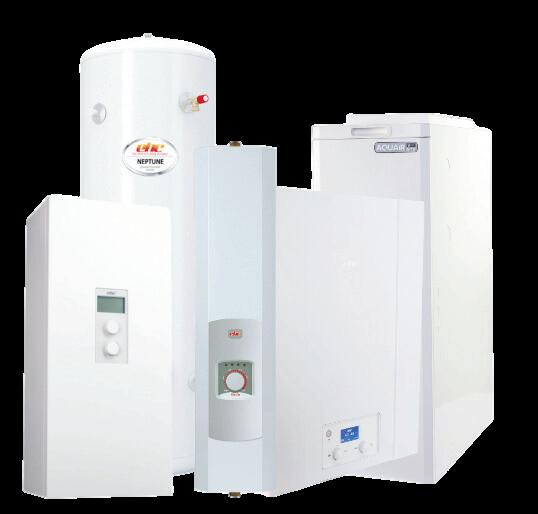

Top 3 benefits of EHC Electric Boilers
1. Zero carbon solution – no gas
2. Simple installation – quick and cost effective
3.No flue required – easy install
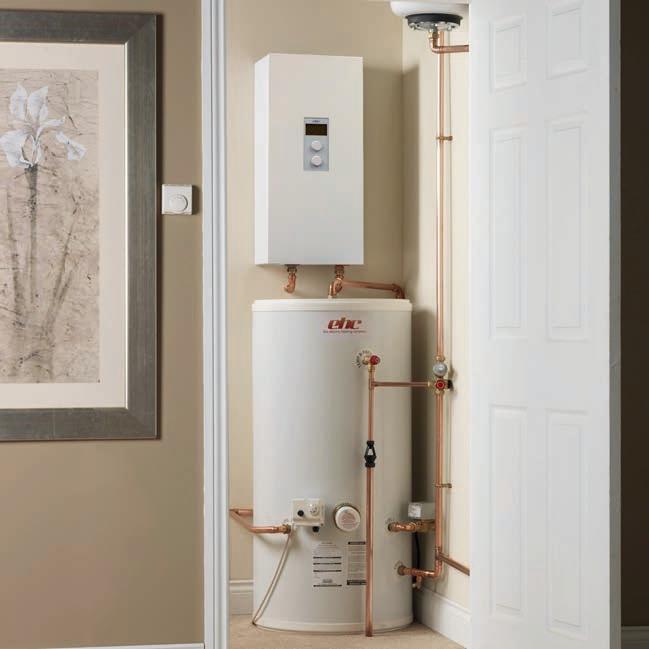

Ventilation danger. Photo credit: Mark Jewell
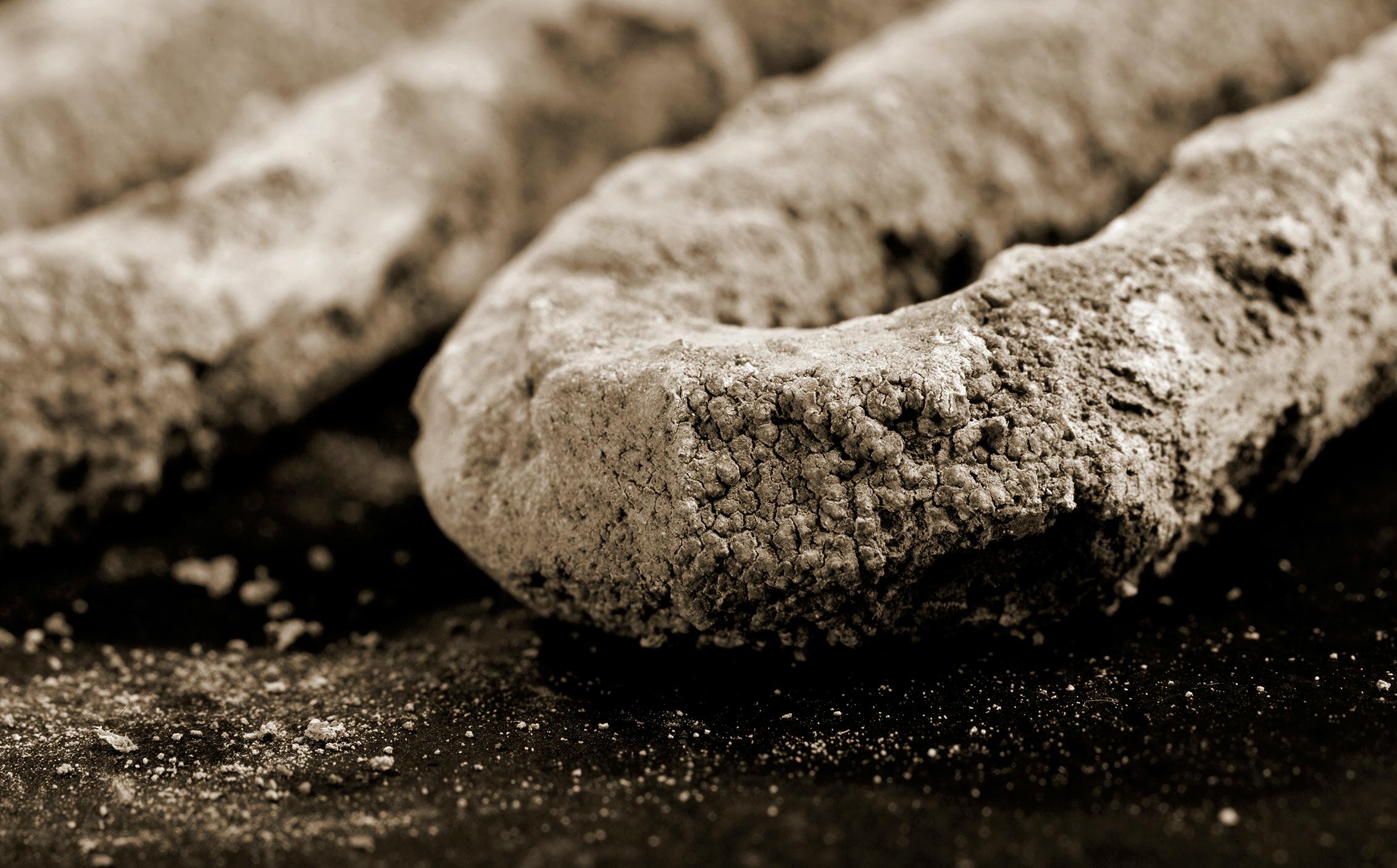
How to counteract heating system corrosion
Gas Safe Register’s Technical Team look at what causes corrosion in central heating systems, how to identify the different types, how to treat it –and how to stop it coming back.
There’s a lot of metal in heating systems, from heat exchangers to pipework and brassware, and the circulating water through these components can lead to corrosion or limescale build-up as the result of chemical or electrolytic action.
When a system has been contaminated, the boiler needs to work much harder to heat the radiators and the domestic hot water. Sludged systems can reduce the heating’s efficiency and even cause system or appliance failure.
Treating the water is a requirement for most central heating systems and following best practice guidance is a fundamental part of installing and maintaining a boiler.
Identifying the issue
There are a number of tests you can use to determine the cause of circulation problems:
• Is the boiler operating correctly? Check the burner pressure/heat input. Does the burner remain alight?
• Consider factors such as premature cycling of the boiler because of restricted heat
exchangers (primary and/or secondary). This can often be confirmed by measuring the differential temperatures of the flow-and-return pipework either side of the heat exchanger(s). These measurements are often referred to as the ‘Delta T’ (differential temperature).
Expect a difference of approximately 20°C for condensing appliances and around 11°C for standard efficiency appliances – but always remember to check the manufacturer’s technical advice.
• Has the appliance(s) become noisy at high temperatures or experienced intermittent overheating? These factors may indicate poor circulation and warrant further investigation.
• Take a sample of the circulating water from the primary circuits. Examine the water for suspended solids
or discolouration, which may indicate corrosion. You can use a turbidity tube for this.
– Reddish water indicates the presence of red iron oxide, suggesting active corrosion. The system may be drawing in air.
– Where black debris is present, this is likely to be magnetite. This is the final stage of corrosion and there may be large deposits in the system.
– If the water is clear, the system is probably free from active corrosion, although this does not eliminate the possibility that there may have been corrosion previously.
• If the system is open vent, check the feed and expansion cistern. Is it clean, with no signs of pumping over or of air being pulled in through the open vent?
• Check the pump.
“Treating the water is a requirement for most central heating systems.”
Which regulations apply?
British Standard 7593:2019: Code of practice for the preparation, commissioning and maintenance of domestic central heating and cooling water systems applies to domestic systems and those in apartment complexes with multiple dwellings.
BS 7593:2019 sets out procedures for the protection of heating and cooling systems against corrosion, sludge, scale and microbiological contamination. It details the key considerations that need to be followed to carry out an adequate system clean.
Is it correctly installed and performing satisfactorily?
Open all radiator valves and, if necessary, vent the radiators. Check whether the problem appears to be localised or general. Is the system correctly balanced, including the adjustment of radiator lockshield valves and any system bypass valves?
• Increase the speed of the pump and monitor. If this improves circulation, it is very important to identify if there are any radiators that fail to heat. This would indicate that the system has a severe flow restriction or may need balancing. Check all valves for free operation. If none are sticking, this is not the cause of the blockage. Once this has been ruled out, draw a sample of water from a cold radiator to check for sludge build-up.
• Do the system radiators need frequent venting? If gas is accumulating in one or more radiators, it is important to determine whether the gas is hydrogen sulphide, hydrogen or air.
– Hydrogen sulphide (H2S) is a by-product of bacteriological activity, and its occurrence is rare. A toxic gas, it has an unmistakeable odour similar to that of rotten eggs and is not easily
confused with the smell of stale water or chemicals.
– Hydrogen (H2) is a byproduct of corrosion. It may be found in new systems where an excess of flux has been applied, causing copper to plate out, as well as in systems with longerterm corrosion. Ongoing corrosion also occurs in older systems that have not been cleaned properly after the installation of new components, such as additional radiators or a replacement boiler.
– If there is air in the system, the problem is likely to be a mechanical one, such as pumping over in an openvented system or poorquality joints under negative pump pressure.
Both H2S and H2 are flammable. This means that you should be aware of where hydrogen might be discharged and the potential danger. For example, an appliance may have an automatic air vent in its combustion case: this could release hydrogen from a corroded system into the combustion circuit, resulting in a flammable gas/air mixture that could be ignited by a call for heat.
Note: You can use a suitable
water testing kit on site or send the samples away for analysis. The results of these tests help to determine what is present in the water sample, which will help you to implement a tailored remedial treatment.
System cleansing
When a central heating system is suffering from the effects of corrosion, it is best practice to clean and protect the components. Before cleansing, examine the system to determine its configuration, age and overall condition, in order to ascertain the cleansing regime required.
For example, in a severely corroded system, removing the debris covering pin holes in radiators could result in leaks. If you’re in any doubt as to whether the system components will withstand the cleansing procedure, then you should repair or replace them before continuing.
Foulants in new systems can include corrosion debris, flux residues, grease, installation debris, metal swarf and particles of solder. Existing systems will often contain black magnetite sludge or scale, etc.
Powerflushing is the most efficient and effective method of cleaning a central heating system.
Systems that use small bore or non-barrier plastic piping may present problems when powerflushing and may require more time. Because non-barrier piping allows oxygen ingress, such a system will usually suffer from severe corrosion problems.
Best practice is to re-pipe the system but if this is not possible it may be powerflushed and the householder advised that the
How to counteract heating system corrosion (continued)
system may need to be flushed regularly. Non-barrier piping will always lead to more corrosion than in other systems.
The method chosen to clean and flush will be determined by the age of the system and level of corrosion. The options, as set out in BS 7593:2019, are:
• Powerflushing
• Mains pressure and clean
• Clean and flush using gravity. If poor circulation as a result of debris and sludge is the problem, then powerflushing should resolve the issue. If H2 production is the problem, and you choose not to powerflush, add a chemical cleaner to circulate for at least 24 hours before the system cleanse process.
If the system is old or there is a great deal of accumulated debris, the chemical cleaner may be left in the system for up to a week. If H2S is found in the system, disinfect it with a suitable sanitiser before the final flush.

and free of foulants before you add inhibitor.
Note: If the system has been producing H2, it may be advisable to add a double dose of corrosion inhibitor. It takes time for active corrosion
“Corrosion inhibitors should not be a substitute for correct system design.”
After cleansing, check the system water with a turbidity tube and an electronic TDS meter.
Inhibitor
The next step should be to treat the system with a suitable multi-metal scale and corrosion inhibitor, following the manufacturer’s instructions, to minimise the likelihood of future corrosion, scale and sludge formation. Make sure the system is thoroughly cleaned
surfaces to become passivated and for hydrogen production to cease. For this reason, allow at least six weeks before further action.
Corrosion inhibitors should not be used as a substitute for correct system design, installation and maintenance. It is essential that levels of corrosion inhibitor are maintained at the correct concentration throughout the life of the central heating system. Do not mix different
inhibitors because of potential compatibility issues. Where radiators have been added or removed during maintenance, this can reduce the concentration of the inhibitor.
Inhibitor levels should be checked regularly and topped up as required with the original product to maintain the correct concentration.
Filters
Filters can make a positive difference to continuing protection, typically combining a magnet to remove black iron oxide with a hydrocyclonic action to remove non-magnetic debris. BS 7593:2019 states that an inline filter should be installed permanently in the system water circuit. This will usually also be a requirement in the boiler manufacturer’s instructions and the warranty may be invalid if they are not installed. The filter must be installed in accordance with the filter manufacturer guidance. ■
DRAYTON MOTORISED VALVES.
SNAPS ON. FITS IN. ZONES OUT.
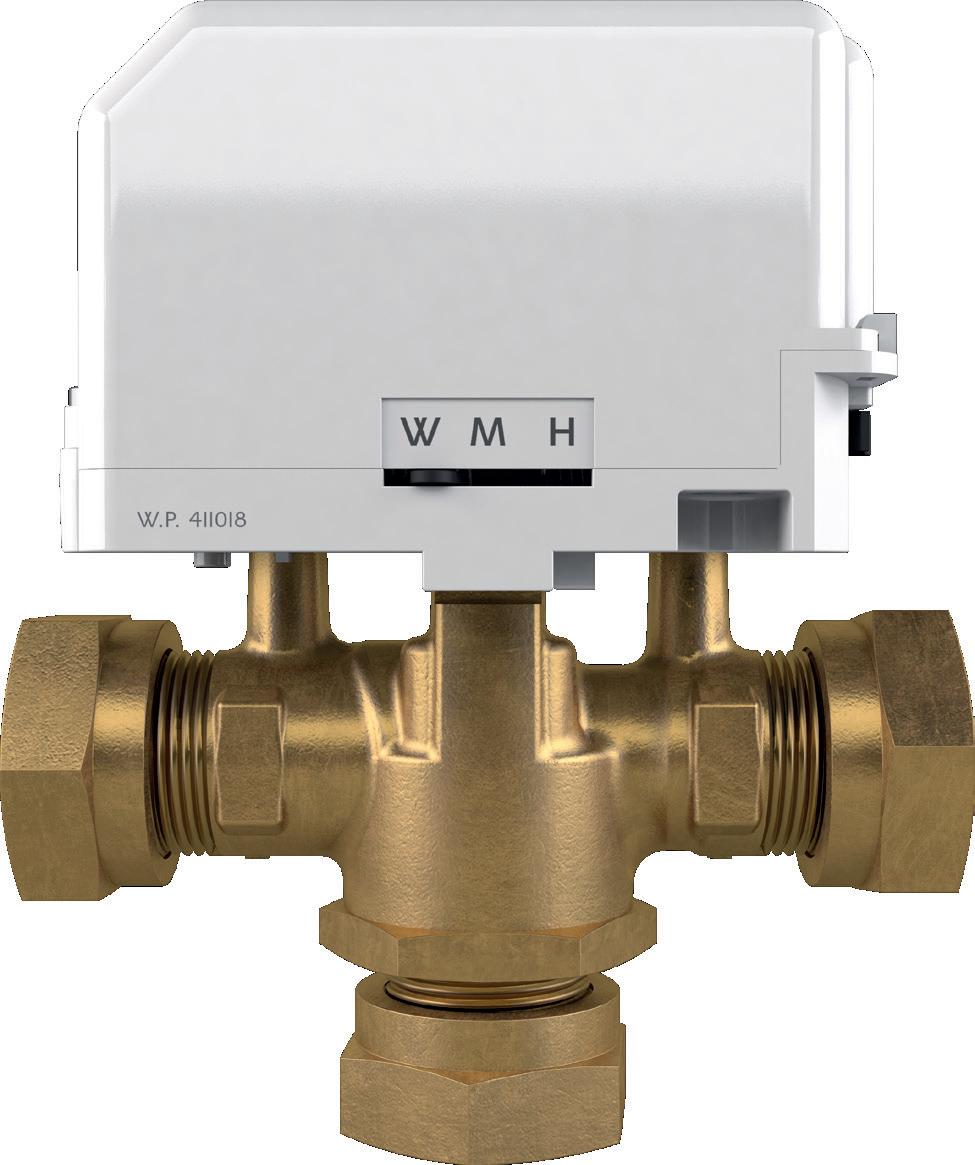
DOUBLE POINTS
A guide to annual boiler servicing
Registered Gas Engineer’s bestpractice guide to boiler servicing.
Servicing the boiler
Have you got the instructions?
Try to find out the boiler’s make and model ahead of the service so that you can download the manual before you go.
Is the boiler working?
Operate the boiler briefly to check whether it seems to work correctly. Isolate the boiler/ heating system electrically and confirm this with suitable test equipment (see also Technical Bulletin 118a). Check that the fuse rating for the boiler/heating system is correct.
Inspect it
Remove the boiler case and visually inspect the appliance internally and externally for any signs of distress, such as corrosion or water leaks.
Clean it
Clean the boiler and its components, including the primary heat exchanger, burner and any condensate trap, in line with the manufacturer’s instructions.
Make sure it’s safe
Safely reinstate the electrical supply. Check the boiler’s gas burner pressure, check the gas rate (at the meter) or both. Check that any boiler safety devices operate correctly.
What’s the picture?
Visually check the flame picture (where visible) and carry out a flue gas analysis test.
What about the seals?
Ensure that any combustion analysis test points are correctly replaced and that the boiler case seals are effective.
Ventilation
Check that any ventilation requirements for the boiler have been met.
Check the flue
Check the boiler chimney/flue throughout its length, including its point of termination. Carry out flue-flow and spillage tests (smoke tests) if the boiler is open-flued.
“Find out the boiler’s make and model ahead of the service so you can download the manual.”
No escape
Check there is no escape of gas from the boiler or connecting pipework.
Follow the procedure
If there are any safety defects, tell the customer and either rectify them or follow the guidance in IGEM/G/11, the Gas Industry Unsafe Situations Procedure (GIUSP). If you can’t fix it, discuss the remedial action required with your customer, along with the options to correct the faults.
Record it
Complete the Benchmark service record and provide any additional work documentation.
Final checks
• Check system controls for correct operation and that both the central heating and hot water function correctly.
• Walk the heating system, checking for any water leaks, signs of corrosion and that all radiators heat evenly, bleeding any air present.
• Check any hot water cylinder for leaks, correct insulation and obvious installation defects.
• Check and clean system sludge/debris from any installed heating system filter.
• For sealed heating systems,
check that the final system pressure is in accordance with the manufacturer’s instructions.
• If the customer is present, discuss the work you have carried out and ask if they have any questions.
• If further work is required, explain what it is, why it is needed, and provide a quotation if the work is not already covered by an existing contract. Try to agree a suitable date and time for the return visit where possible. When returning to carry out further work or repairs, ensure that all relevant parts and materials are ordered for the job and that these are as specified by the manufacturer (also see page 21).
• Check that the appliance and system control settings (eg, on/off times for the central heating and thermostat settings) are as the customer requires, or are left as you found them.
• If you have not already recorded information about
“Walk the heating system, checking for water leaks, signs of corrosion and that radiators heat evenly.”
the service directly on to the Benchmark service record, add the relevant appliance readings and information and record a short job report, including any parts fitted.
• Advise the customer that continued regular servicing of their gas appliances is recommended, and that it is a condition of any appliance manufacturer’s warranty that gas boilers are appropriately serviced, at least annually.
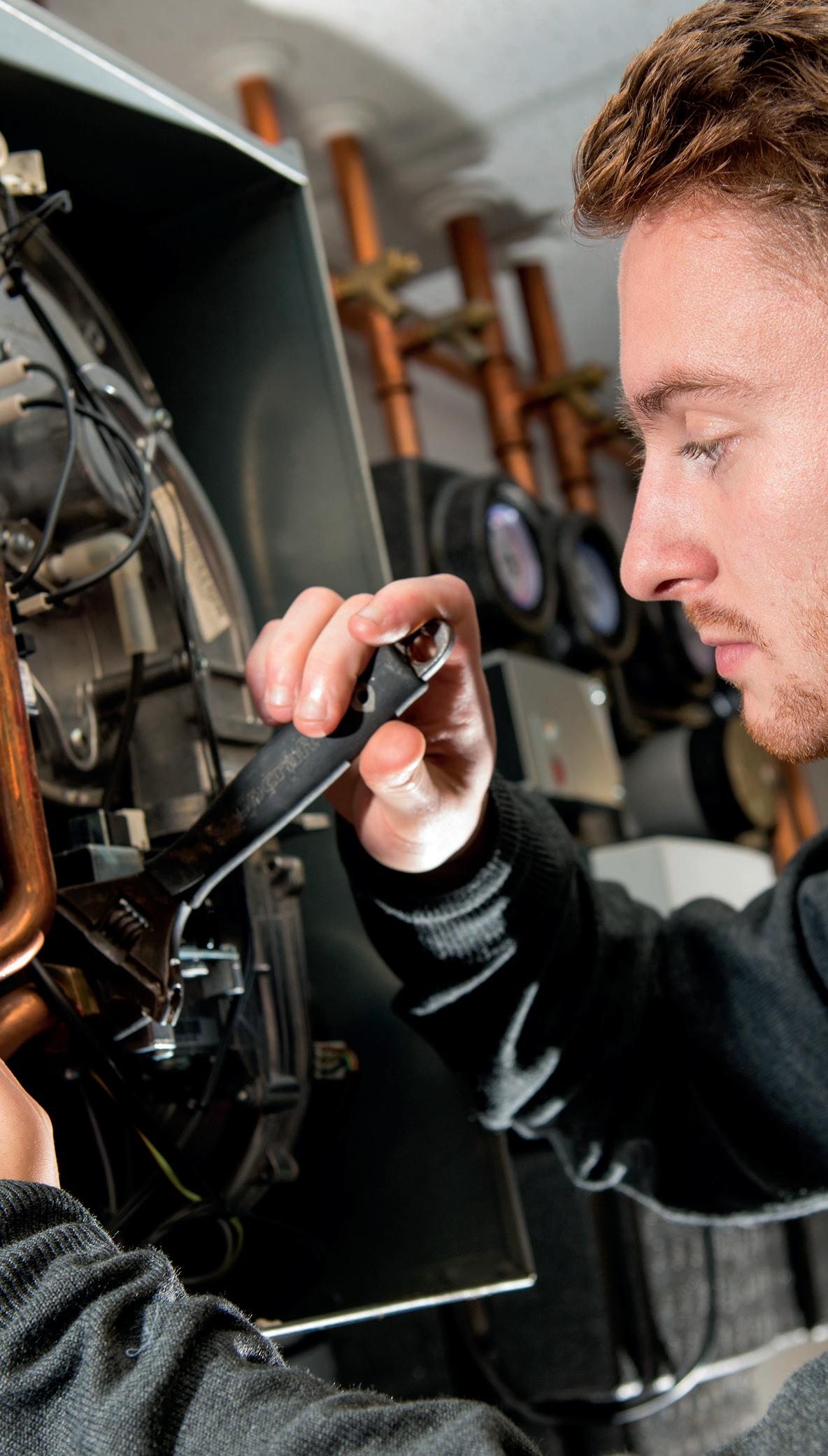
• Check that any audible carbon monoxide (CO) alarm installed in the home is in date, operating correctly, appropriately located and installed, and that it conforms to BS EN 50291.
• If the customer does not have a CO alarm, advise them of the benefits.
Note: A CO alarm is not a substitute for regular servicing of gas and other fuel-burning appliances.
The truth about official spares
Heating professionals take immense pride in quality workmanship, ensuring safety and reliability in every job. To maintain high standards, it’s crucial to use the right components, including official manufacturer spares. These parts are designed, tested and approved to meet the highest industry standards, ensuring long-lasting performance, safety and peace of mind.
Why official spares matter
Each installation or repair needs to be done right, not only for immediate performance but also for long-term reliability and the safety of the system. Using only official manufacturer spares provides several key benefits:
• Perfect fit and performance – parts are
designed specifically for each appliance, ensuring compatibility and efficiency.
• Safety and compliance –official spares are fully tested and meet regulatory safety standards, reducing the risk of faults or failures.
• Manufacturer-backed warranties – these spares protect both engineers and customers, providing assurance that the repairs meet all required specifications.
Supporting the heating industry
There is growing concern over non-official parts entering the market at lower prices. While these parts may seem like a cost-effective alternative, they can lead to long-term issues.
When engineers choose
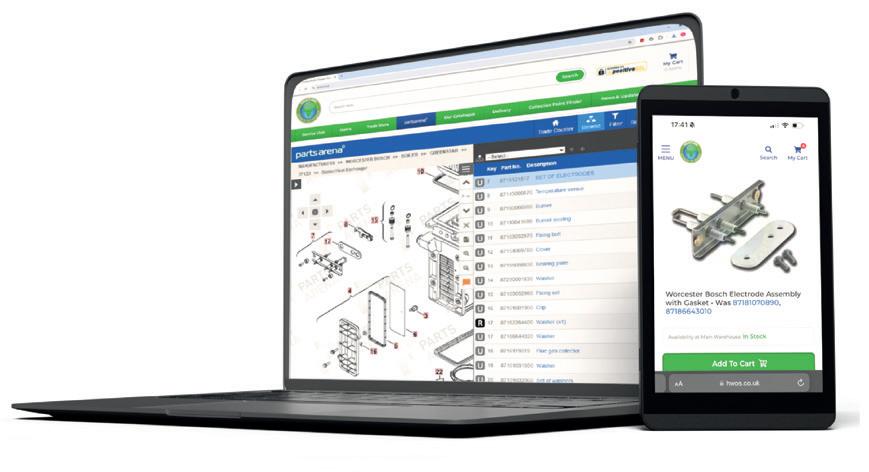
official spares, they not only protect the appliances they work on but uphold the integrity of their business and the manufacturers that invest in producing reliable heating systems.
It’s crucial that engineers and manufacturers work together to support the use of official parts. By doing so, we can ensure that heating systems remain safe, reliable, and efficient. n
Heating World of Spares is committed to supporting heating engineers and manufacturers with official parts.

Don’t fall for counterfeits
Ian
Trott, head of UK Training
Solutions at Baxi, highlights why it’s important to identify and choose genuine spare parts – and the risks of using fakes.
Genuine spare parts are manufactured to exact specifications and undergo rigorous testing to ensure they perform reliably. A precise fit with existing equipment minimises the risk of future complications, providing both peace of mind and sustained system efficiency. Moreover, genuine parts typically come with a manufacturer’s warranty. By contrast, counterfeit parts – although they may appear suitable – often lack durability and precision, potentially leading to system malfunctions or even serious safety hazards.
Parts’ warranties are an important consideration because they protect both the installer and the homeowner by ensuring that any failures are addressed by the manufacturer. In contrast, using unauthorised components shifts the burden of any breakdown directly on to the heating engineer, potentially voiding warranties and damaging reputations.
It’s important to understand the risks of using counterfeit spares but so too is knowing exactly how to spot them.
Watch out
Stay alert when assessing spare parts:
• Packaging quality: genuine parts come in high-quality packaging with clear, accurate labels
• Price discrepancies: an unusually low price is a strong signal of a counterfeit product. Authentic spare parts are priced to reflect their quality. If a price seems too good to be true, it probably is
• Unverified sellers: only buy from authorised dealers or reputable vendors to avoid substandard products
• Material quality: genuine components are made from high-grade materials. If a part feels oddly light or appears flimsy, it may be counterfeit.
The consequences of counterfeits
The risks associated with counterfeit parts far outweigh any cost savings. Safety is the primary concern because unauthorised components may fail unpredictably, increasing the risk of additional damage to the product.
How to find genuine spares
Baxi’s PartsArena database is a comprehensive online tool that simplifies identifying the correct components, providing detailed information, including part numbers and technical specifications. The PartsArena database can be accessed via Baxi’s ToolBelt app. www.baxi.co.uk/professional/services/spare-parts/partsarena
Performance issues may arise from using non-genuine parts, leading to system inefficiencies, unexpected breakdowns and higher energy consumption.
The apparent savings from counterfeits can be a false economy for the installer and homeowner.
In a worst-case scenario, if a failure is due to counterfeit parts, the installer may face not only financial liability but also damage to their professional reputation. n
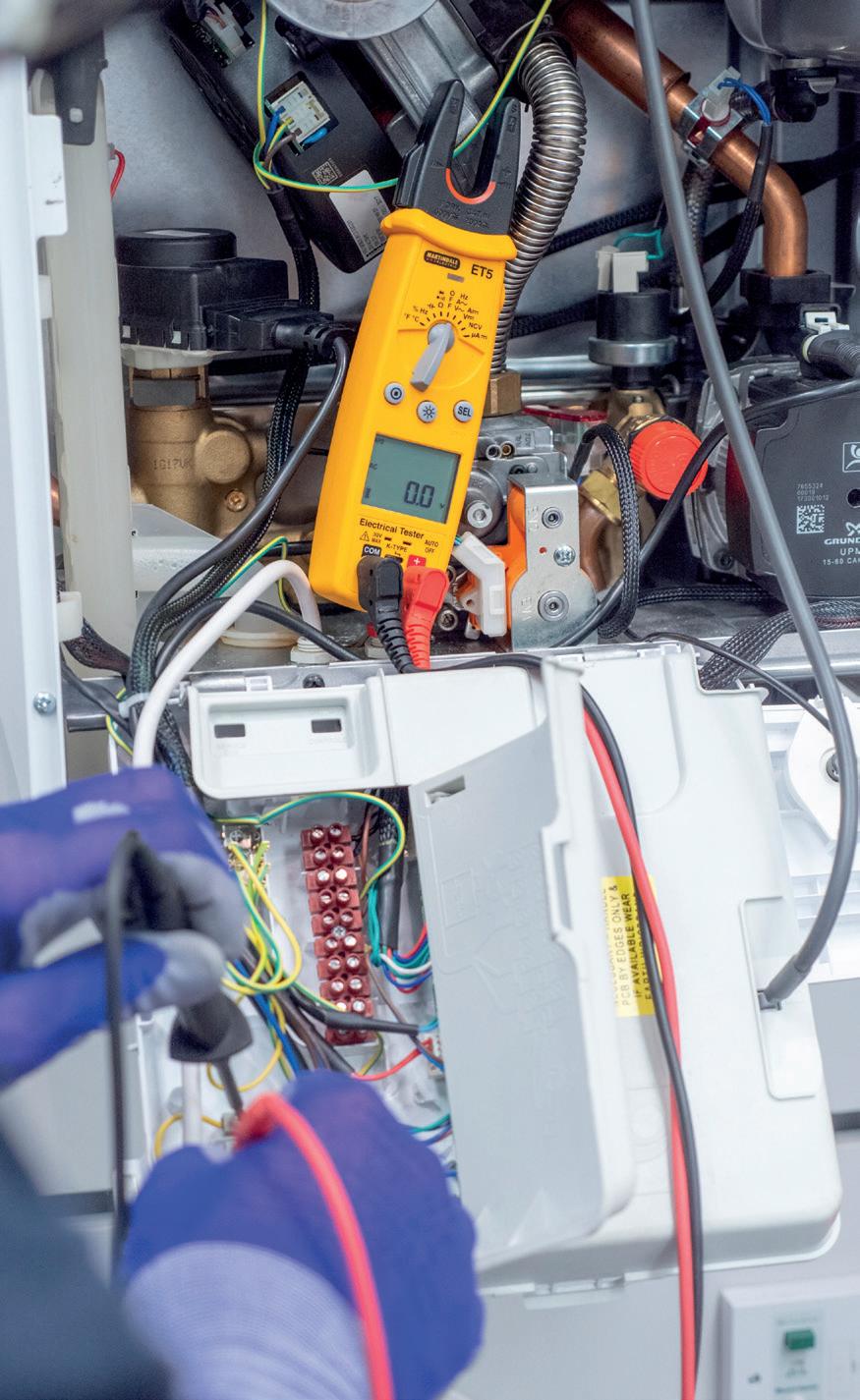
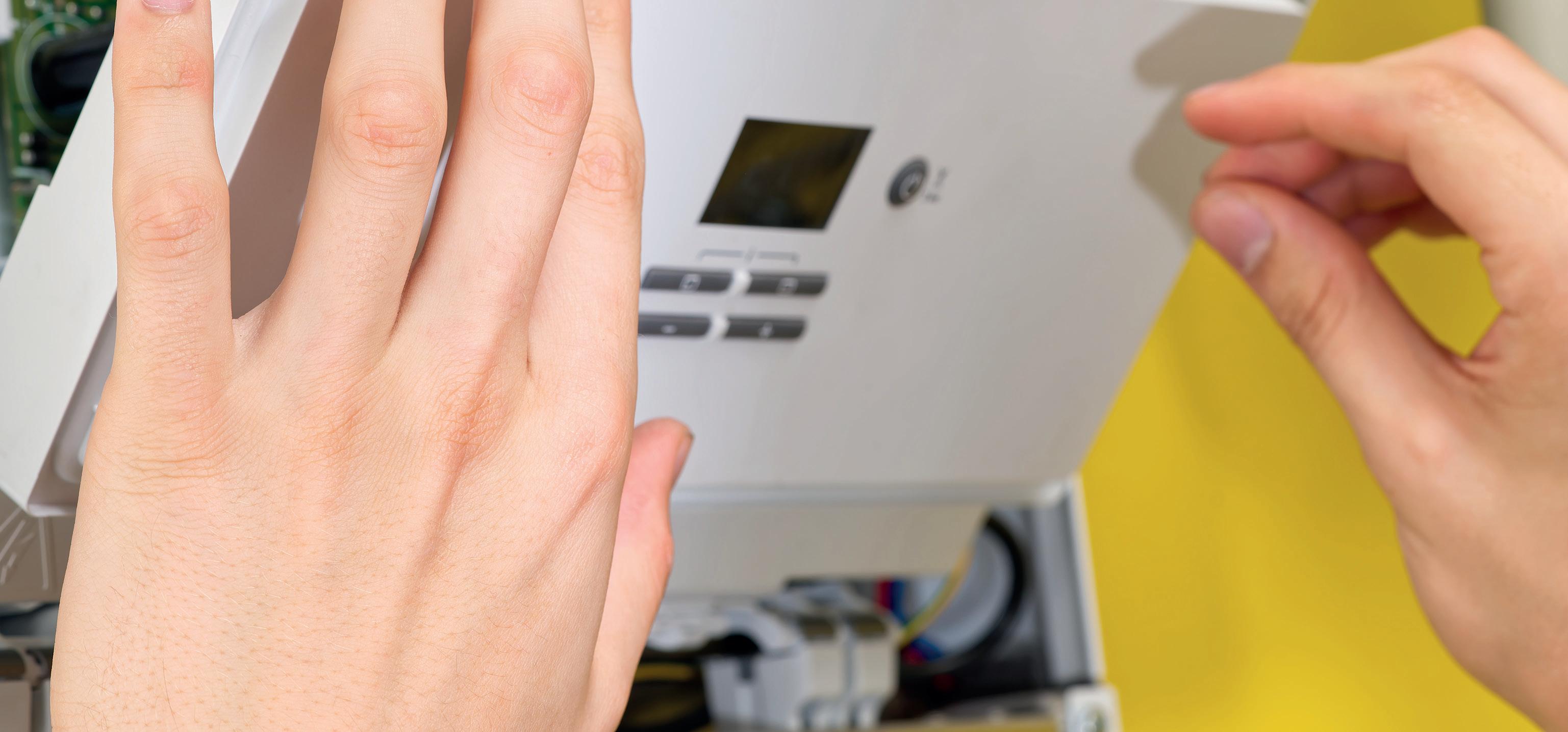
Are safety checks enough?
Should mandatory landlords’ gas safety checks be replaced by a full appliance service and review of the efficiency of heating systems?
The HHIC and EUA believe that upgrading gas safety checks to a full service would be good for both landlords and tenants. The annual service requires a more in-depth examination of the appliance, making sure it is in good working order and not just safe to operate. Enhancing the service further to include the heating system would mean that the efficiency of the product at warming the home is also considered.
HHIC director Stewart Clements said: “Upgrading a simple gas safety check to a full service will offer the landlord the ability to make sure the appliance is working properly and checks to see the likely wear and tear, just like a car MOT does.
Planned replacement
“It can identify when an appliance might be coming to the end of its life, giving the landlord time to plan their next purchase.
“Tagging on a heating system check will allow the installer to make sure the
system is running as efficiently as possible, keeping bills down for the tenant. Even checking that the flow temperatures on the boiler are lower can yield significant bill savings.”
Mike Foster, CEO of EUA, added: “There are ambitious plans to improve the EPCs
manager John Williams added: “Scheduling regular services helps ensure the boiler is working as efficiently and effectively as possible, supporting a long product life. Servicing is required under the terms of the boiler guarantee or extended warranty: without it,
“Servicing can identify when an appliance might be coming to the end of its life.”
of private rented homes, which is welcome, but with a simple upgrade from a gas safety check to a system and appliance service, tenants could save £100s and landlords can plan for the future with greater certainty.
“We support the call for mandatory annual servicing of all heating appliances – but a good first step is surely to upgrade the annual safety check to something even more meaningful.”
It’s an opinion echoed by Viessmann, whose operations
customers risk invalidating their contracts and facing the cost of repairs or replacement.”
Martyn Bridges, director at Worcester Bosch, added: “Regular boiler servicing not only helps in maintaining efficiency but also prevents unexpected breakdowns, ensuring that the heating system operates safely and effectively until the next service. When followed correctly, this approach is key to extending the life of the boiler and ensuring customer satisfaction.” n
Safe handling of nonrefillable LPG cylinders
Liquid Gas UK has issued a new guidance sheet to support the safe storage and transportation of LPG and propylene non-refillable cylinders in the plumbing and heating sectors.
Non-refillable cylinders designed for blowtorches and widely used for soldering, brazing and general heating applications, can often be mistaken for camping gas canisters, which have different storage and transport requirements.
Guidance sheet GS40(1) has been developed by Liquid Gas UK, in collaboration with European standard bodies and the Department for Transport, to provide a clear point of reference for safely storing, transporting, marking and disposal of the cylinders.
Practical guidance
Richard Hakeem, director of Technical and Safety Policy at Liquid Gas UK, says: “This new document is designed to give free, practical guidance for builders and plumbers merchants, wholesalers, stockists and DIY retailers, where trade professionals and the public typically purchase non-refillable cylinders.
“It also serves as a resource for local authorities and Trading Standards teams to assess compliance when inspecting businesses.
“Before the publication of GS40, there was no single, concise reference guide consolidating all relevant
Bibliography
regulations, standards and best practices for these specific cylinders.
“The new guidance aims to resolve this lack of clarity, distinguishing between trade use, non-refillable cylinders and canisters used for portable cooking appliances, outlining clear responsibilities for suppliers.
“Those handling nonrefillable cylinders must understand the properties and hazards of LPG and propylene, ensure correct equipment selection, such as regulators, and implement essential fire and safety precautions. Basic safety information must also be provided at the point of sale to ensure proper usage.”
GS40 aims to reduce safety risks by providing clear guidance on proper storage and transport limits, clarify legal obligations for businesses stocking the cylinders, and support Trading Standards teams in enforcing safe practices.
It references the European Agreement concerning the International Carriage of Dangerous Goods by Road (ADR) transport regulations and the Dangerous Substances and Explosive Atmospheres Regulations (DSEAR) storage requirements. n
(1) Liquid Gas UK Guidance Sheet 40: GS40 Guidance on storage, marking, transportation and disposal of LPG and propylene non-refillable cylinders
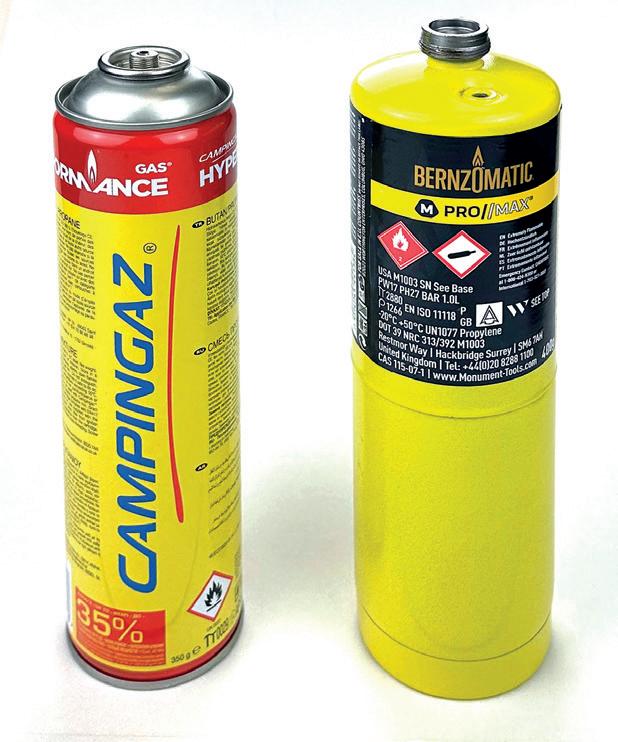
Campingaz UN2037 and Bernz Pro-Max UN1077: Non-refillable LPG cylinders (right) are often confused with camping gas canisters (left)
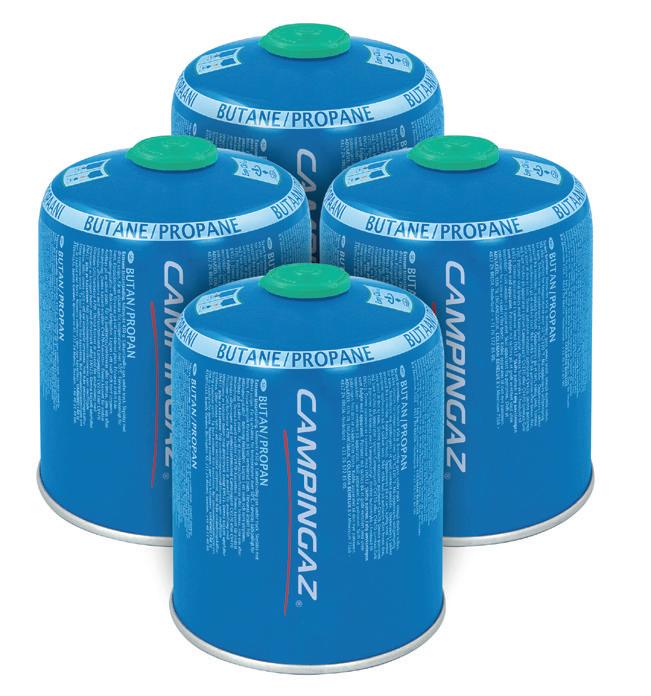
CV470 Plus 4 pack: Camping gas canisters have different storage and transport requirements from trade-use, non-refillable LPG and propylene cylinders. Picture supplied courtesy of Campingaz
Legislative, Normative & Informative
The Gas Safe Register Legislation & Standards Document List
Date issued: 1 April 2025
Introduction
This document defines all documents recognised by Gas Safe Register as being Legislative, Normative (gas standards) and Informative reference documents.
Some documents may only be available as hard copy documents, but the majority are available to download, either via Gas Safe Register’s engineer website or from the organisation or body promoting the document. In some cases, the document is only available for purchase from the organisation or a recognised supplier.
Hierarchy of legislation and standards
In this document list, the hierarchy of documents within the following tables is defined in order of significance.
Detailed first are Statutory Acts or regulations that are legally enforceable. These are followed by a recognised list of documents known as ‘second tier’ documents. This series of documents provides practical guidance on ways to comply with the functional requirements of Regulations. This guidance is not law, but provides information that, if followed correctly, will ensure that legal obligations have been met.
Where someone chooses to depart from this guidance, they will need to ensure that the method chosen provides equivalent or better standards of safety than the relevant published guidance. The guidance provided within appropriate second-tier documents will be used to assess compliance.
The next tier of documents is gas industry standards that are aimed specifically at the installation, commissioning or maintenance of gas equipment (pipework, appliances, etc). These are known as Normative Documents and are referred to as ‘Gas Industry Standards’. These documents, in conjunction with any available manufacturer’s instructions, will be used by
Gas Safe Register to assess compliance.
Finally, the remaining listings provide details of other available information that may be useful to help registered businesses comply with their obligations and assist them in carrying out their day-to-day activities. These are referred to as Informative Documents.
1. Hierarchy of documents Legislation
In this section, the listed documents are those brought to the Statute Book by an Act of Parliament and are referenced as Statutory Instruments (SI) or equivalent. These are the law in the respective countries as stated and must be followed. The SI Reference number (or equivalent) is preceded by the year of it being added to the Statute Book, ie, the Gas Safety (Installation and Use) Regulations 1998 has an SI number of 1998:2451. Regulations are in general written in a format that provides high-level requirements.
Documents supporting legislation
These documents provide practical guidance on ways to comply with the functional requirements of the Regulations. For the Building Regulations, these are outlined in a series of Approved Documents (AD) published by the appropriate government department responsible for the Regulations.
The ADs that currently apply to gas work are:
• A Structure
• B Fire safety
• F Ventilation
• G3 Hot water storage
• J Heat producing appliances
• L Conservation of fuel and power
• M Access to and use of buildings
• P Electrical safety in dwellings.
Each document contains general guidance on the performance expected of materials and building work to comply with
each of the requirements of the Building Regulations and practical examples and solutions on how to achieve compliance for some of the more common building situations.
2. Gas Industry Standards
In this section are all the Gas Industry Standards published by the three current Standard Setting Bodies, which are:
• British and European Standards (BSI)
• Institution of Gas Engineers and Managers (IGEM)
• Liquid Gas UK (formerly known as UKLPG).
One standard is published by National Caravan Council (NCC).
3. Documents under review
If it is known that the threemonth validity period coincides with a period of time in which a standard being revised is out for public comment, the final date for comment will be included.
Gas Safe Register will use best endeavours to keep the documents under review as up to date as possible, but the Register is NOT responsible for reviewing, revising or updating industry standards. Where a registered business or industry stakeholder has an enquiry about revisions to guidance documents, this should be directed to the relevant Standard Setting Body.
Comments on draft standards can be submitted to:
• British and European Standards (BSI) https:// standardsdevelopment. bsigroup.com (registration required)
• Institution of Gas Engineers and Managers (IGEM) www.igem. org.uk/technical-standards.html
4. Links to online documents
When viewing this document online, hyperlinks are active, so that you can open the document and read it or save it for later use. However, all saved documents will be considered as uncontrolled versions and you should check that you are referencing the current version.
5. Inspections undertaken by Gas Safe Register
When Gas Safe Register inspects work undertaken by registered gas businesses in Great Britain, Northern Ireland, the Isle of Man and Guernsey, in the first instance, it will assess against the manufacturer’s installation instructions. Where these are not available or relevant, it will inspect against the criteria as specified within legislative documents and relevant gas industry standards. However, it is recognised that, due to the differences of individual legislation used in different geographical areas, there will be some differences in application. While conducting inspections, due regard will be taken of the requirements of all appropriate guidance.
6. General
This Gas Safe Register document will be updated and republished on, or about, the following dates each year:
• 1 January
• 1 April
• 1 July
• 1 October.
If you identify an error in this document, or you are aware of reference documents that may be useful that you think should be added to future editions, please email: technical@ gassaferegister.co.uk
BSI, IGEM and Liquid Gas UK develop and publish guidance with the help of industry in the form of committees. Gas Safe Register does not have any responsibility for the development and publication of this type of guidance document. Where registered businesses and stakeholders have questions regarding these guidance documents, they should be directed to the relevant Standard Setting Body.
7: LEGISLATION
Health & Safety Legislation
Health & Safety at Work etc Act
1974 (GB)
The Management of Health & Safety at Work Regulations 1999 (GB)
The Workplace (Health, Safety and Welfare) Regulations 1992 (GB)
Health & Safety at Work (Northern Ireland) Order 1978
Health & Safety at Work etc Act
1974 (of Parliament) (As applied to Isle of Man)
The Construction (Design & Management) Regulations 2003 (As applied to Isle of Man)
The Health & Safety at Work (General) (Guernsey) Ordinance, 1987 As Amended –Version 7 September 2020
Gas Safety Legislation
The Gas Safety (Installation & Use) Regulations 1998 (England, Scotland & Wales)
The Gas Safety (Installation & Use) Regulations (Northern Ireland) 2004
Gas Safety (Installation & Use) Regulations 1998 as amended & applied by the Gas Safety (Installation, Use and management) (Application) Order 2021 (As applied to Isle of Man)
The Health & Safety (Gas) (Guernsey) Ordinance, 2006 As Amended Version – May 2016
Safe work with Gas Systems & Appliances, Approved Code of Practice – Health & Safety at work (Jersey) Law, 1989 – 1st February 2021
The Gas Appliances (Safety) Regulations 1995 (As applied in the United Kingdom)
The General Product Safety Regulations 2005
The Gas Safety (Management) Regulations 1996 (As applied in Great Britain) (AMD 2023)
The Gas Safety (Management) Regulations (Northern Ireland) 1997
The Gas Safety (Rights of Entry) Regulations 1996 (as applied to Great Britain)
The Gas (Northern Ireland) Order 1996, Schedule 5 (Powers of Entry, etc)
Gas Safety (Rights of Entry) Regulations 1983 as applied by the Gas Safety (Application) Order 1996 (Isle of Man)
Part 7 of The Health & Safety (Gas) (Guernsey) Ordinance, 2006 As Amended Version May 2016
Reporting of Injuries, Diseases and Dangerous Occurrences (RIDDOR)
The Reporting of Injuries, Diseases & Dangerous Occurrences Regulations 2013 (RIDDOR) (GB)
Reporting of Injuries, Diseases & Dangerous Occurrences Regulations (Northern Ireland) 1997
Reporting of Injuries, Diseases & Dangerous Occurrences Regulations 1999 (RIDDOR) (Isle of Man)
The Health & Safety at Work (General) (Guernsey) Ordinance, 1987 (includes RIDDOR-type reporting)
Building Legislation
Building Regulations (England and Wales) 2010
Building and Buildings, England & Wales, The Building Regulations &C (Amendment) Regulations 2015
Building Regulations &c. (Amendments) (Wales) Regulations 2013
Building Standards (Scotland) Regulations 2004
Building (Scotland) Amendment Regulations 2010
Building (Scotland) Amendment Regulations 2011
Building (Miscellaneous Amendments) (Scotland) Regulations 2013
Building (Scotland)
Amendment Regulations 2022
Building Regulations (Northern Ireland) 2012
The Building (Guernsey) Regulations 2012
Building Bylaws (Jersey) 2007
Building Regulations 2014 (Isle of Man)
Construction (Design & Management) Regulations 2015 (Great Britain)
The Construction (Design & Management) Regulations (Northern Ireland) 2016
The Construction (Design & Management) Regulations 2003 (As applied to Isle of Man)
Building Control (Approved Documents) (No 2) Order 2019 (As applied to Isle of Man)
Other Legislation
The Workplace (Health, Safety and Welfare) Regulations 1992
The Dangerous Substances & Explosive Atmospheres Regulations 2002 (DSEAR) (GB)
Control of Substances Hazardous to Health Regulations 2002 (COSHH) (GB)
The Pressure Equipment (Safety) Regulations 2024
The Pressure Equipment (Amendment) Regulations 2015 (UK)
The Pressure Systems Safety Regulations 2000 (GB)
Control of Asbestos at Work Regulations 2002 (GB)
Control of Asbestos at Work (Northern Ireland) Regulations 2003
The Control of Asbestos Regulations (GB) 2012
The Control of Asbestos Regulations (Northern Ireland) 2012
Managing asbestos (Isle of Man)
HSE Guernsey – Management of Exposure to Asbestos in Workplace
Buildings and Structures – ACOP
HSE Guernsey – Control of Asbestos – ACOP 2017
The Electricity at Work Regulations 1989 (GB)
Electricity At Work Regulations (Northern Ireland) 1991
Note 1: Further information on ordinances in Guernsey at: www.gov.gg/hseguidance
Note 2: Further information on legislation in the Isle of Man at: www.gov.im/categories/planningand-building-control/
8: DOCUMENTS SUPPORTING LEGISLATION
Key Approved Documents to the Building Regulations (England)
Approved Document 7: Materials and workmanship
B: Fire Safety – Volume 1: Dwelling houses
B: Fire Safety – Volume 2: Buildings other than dwelling houses
F: Ventilation Volume 1: Dwellings
F: Ventilation Volume 2: Buildings other than dwellings
G: Sanitation, hot water safety & water efficiency (2016 edition)
J: Combustion Appliances & Fuel Storage Systems
L: Conservation of fuel and power – Volume 1: Dwellings
L: Conservation of fuel and power – Volume 2: Buildings other than dwellings
Second-tier documents to the Building Regulations – England Code for Sustainable Homes & Technical Guide December 2014
Building Energy Performance Assessment
Key Approved Documents to the Building Regulations (Wales)
B: Fire Safety – Volume 1: Dwellinghouses
B: Fire Safety – Volume 2: Buildings other than dwellinghouses
F: Ventilation – Volume 1: Dwellings
F: Ventilation – Volume 2: Buildings other than dwellings
G: Sanitation, hot water safety & water efficiency (2018 edition)
J: Combustion Appliances & Fuel Storage Systems
L: Conservation of fuel and power – Volume 1: Dwellings
L: Conservation of fuel and power – Volume 2: Buildings other than dwellings
Second-tier documents to the Building Regulations – Wales Code for Sustainable Homes & Technical Guide December 2014
Building Energy Performance Assessment
Key Approved Documents to the Building Standards (Scotland) Regulations (Domestic)
Scottish Technical Handbook (Domestic)
Section 2 – Domestic Fire
Section 3 – Domestic Environment
Section 6 – Domestic Energy
Building Energy Performance Assessment
Key Approved Documents to the Building Standards (Scotland) Regulations (Non-Domestic)
Scottish Technical Handbook (Non-Domestic)
Section 2 – Non-Domestic Fire
Section 3 – Non-Domestic Environment
Section 6 – Non-Domestic Energy
Second-tier documents to the Building Standards (Scotland) Regulations
Scottish Government Guide to the Condensing Boiler Installation Assessment
Building Energy Performance Assessment
Key Approved Documents to the Building Standards (Regulations) Northern Ireland
DFP Technical Booklet C: 2012 –Site preparation & resistance to moisture
DFP Technical Booklet E: 2012 –Fire Safety
DFP Technical Booklet F1: 2022 –Conservation of fuel & power in dwellings
DFP Technical Booklet F2: 2022 –Conservation of fuel & power in buildings other than dwellings
DFP Technical Booklet K: 2012 – Ventilation
DFP Technical Booklet L: 2012 –Combustion appliances & fuel storage systems
DFP Technical Booklet P: 2012 –Sanitary appliances, unvented hot water storage systems and reducing the risk of scalding Building Energy Performance Assessment
Key Approved Documents to the Building Regulations Isle of Man (IoM)
B – Fire Safety – Fire safety (2022 Edition)
F – Ventilation (2022 Edition)
J – Combustion Appliances & Fuel Storage Systems (2022 Edition)
L1 – Conservation of Fuel & Power in Dwellings (2022 Edition)
L2 – Conservation of Fuel & Power in Buildings other than Dwellings (2022 Edition)
Building Energy Performance Assessment
>
Key Approved Documents to the Building Bylaws (Guernsey) –Channel Islands
B – Fire Safety – Volume 1: Dwelling houses
B – Fire Safety – Volume 2: Buildings other than dwelling houses
F – Ventilation
J – Heat producing appliances & Fuel Storage Systems
L1 – Conservation of Fuel & Power in Dwellings
L2 – Conservation of Fuel & Power
– Buildings other than Dwellings
Building Energy Performance Assessment
Key Approved Documents to the Building Bylaws (Jersey) –Channel Islands
Part 2 – Fire Safety
Part 3 – Combustion appliances and Fuel Storage Systems
Part 5 – Ventilation
Part 11 – Conservation of Fuel and Power
HSE Publications and other Approved Codes of Practice (Great Britain)
L21 – Management of Health & Safety at Work Withdrawn. See HSG65
L24 – Workplace health, safety & welfare (ACoP & Guidance) 2nd Edition
L25 – Personal Protective Equipment at Work
L56 – Safety in the Installation & use of Gas Systems & Appliances
– Approved Code of Practice
L80 – A guide to the Gas Safety (Management) Regulations 1996
L108 – Controlling noise at work
– The Control of Noise at Work Regulations 2005 – Guidance on Regulations
L122 – Safety of pressure systems
– Pressure Systems Safety Regulations 2000 – Approved Code of Practice (Second Edition)
L138 – Dangerous Substances & Explosive Atmospheres. Dangerous Substances & Explosive Atmospheres Regulations 2002. Approved Code of Practice & Guidance
L143 – Control of Asbestos Regulations 2012 (ACoP) –The management of asbestos in non-domestic premises, and Work with materials containing asbestos (Second Edition) Incorporating previous L127
L153 – Managing health & safety in construction – Construction (Design & Management) Regulations 2015 Approved Code of Practice
HSG47 – Avoiding danger from underground services –Third edition 2014
HSG48 – Reducing error & influencing behaviour
HSG65 – Managing for Health & Safety Management –Third Edition – 2013
HSG85 – Electricity at Work –Safe working practices –Third Edition 2013
HSG97 – A step by step guide to Control of Substances Hazardous to Health (COSHH) assessment (see also COSHH Essential Guidance publications)
HSG137 – Health Risk Management – A practical guide for managers in small & medium-sized enterprises
HSG176 – The storage of flammable liquids in tanks
HSG210 – Asbestos Essentials –A task manual for building, maintenance & allied trades on non-licensed asbestos work (Free task sheets)
HSG213 – Introduction to Asbestos Essentials
HSG250 – Guidance on permit-towork systems: A guide for the petroleum, chemical & allied industries
HSG253 – The safe isolation of plant and equipment (Second edition)
HSG261 – Health & safety in motor vehicle repair and associated industries
EH40 – Workplace Exposure Limits (2020)
INDG163 (rev4) – Risk assessment (A brief guide to controlling risks in the workplace)
INDG223 (rev5) – Managing asbestos in buildings (A brief guide)
INDG231 (rev1) – Electrical safety and you (A brief guide)
INDG258 (rev1) – Confined spaces (A brief guide to working safely)
INDG428 (08/09) – Inspecting and maintaining or replacing buried metallic pipework carrying LPG vapour
INDG223 (rev5) – Manage asbestos in buildings: A brief guide
INDG370 (rev1) – Controlling Fire and explosion risks in the workplace – A brief guide to the Dangerous Substances and Explosive Atmospheres Regulations (DSEAR)
INDG453 (rev1) – Reporting accidents and incidents at work. A brief guide to the Reporting of Injuries, Diseases and Dangerous Occurrences Regulations (RIDDOR)
HSE AO – Advice on non-licensed work with Asbestos. Introduction to ‘Asbestos essentials’ task sheets
Control of Substances Hazardous to Health (COSHH) Essentials guidance publications
Guidelines on ventilation, thermal comfort and indoor air quality in schools
LAQM.TG(22) Local Air Quality
Management – Technical Guidance
CAIS10 (Revision 3) – Ventilation of kitchens in catering establishment
CAIS23 (Revision 3) – Gas safety in catering and hospitality
Note 3: Further asbestos-related guidance at: www.hse.gov.uk/ asbestos/information.htm
Note 4: Further Health and Safety Guidance (HSG) publications at: www.hse.gov.uk/pubns/books/ index-hsg-ref.htm
HSENI Publications and other Approved Codes of Practice (Northern Ireland)
A guide to the Reporting of Injuries, Diseases & Dangerous Occurrences Regulations (Northern Ireland) 1997
L56 Safety in the installation and use of gas systems and appliances
– GB ACOP approved for use in NI
Memorandum of guidance on the Electricity at Work Regulations (Northern Ireland) 1991
Note 5: Further information on Northern Ireland Approved Codes of Practice and guidance notes at: www.hseni.gov.uk/publications
HSE Publications and other Approved Codes of Practice (Guernsey)
Safety in the Installation & Use of Gas Systems & Appliances. The Health & Safety (Gas) (Guernsey) Ordinance 2006
The Organisation & Management of Health & Safety in Construction (Guernsey)
Reporting an Injury, Disease or Dangerous Occurrence (Guernsey)
Note 6: Further information on Approved Codes of Practice and guidance notes for gas safety and other important issues at: www.gov.gg/hseguidance
9: GAS INDUSTRY STANDARDS
British & European Standards
BS 4163: 2021 + A1: 2022 Health and safety for design and technology in schools and similar establishments. Code of practice
BS 3632: 2023 Residential park homes – Specification
BS 5440-1: 2023 Chimneys, flue pipes and ventilation for gas appliances of rated input not exceeding 70kW net (1st, 2nd and 3rd family gases). Design, installation, commissioning and maintenance of chimneys. Specification
BS 5440-2: 2023 Chimneys, flue pipes and ventilation for gas appliances of rated input not exceeding 70kW net (1st, 2nd and 3rd family gases). Installation and maintenance of ventilation provision for gas appliances. Specification
BS 5546: 2010 Specification for installation and maintenance of gas-fired water-heating appliances of rated input not exceeding 70kW net
PD 54823: 2016 Guidance for the design, commissioning, and maintenance of LPG systems in small craft
BS 5864: 2019 Installation and maintenance of gas-fired ducted air heaters of rated input not exceeding 70kW net (2nd and 3rd family gases). Specification
BS 5871-1: 2005 Specification for the installation and maintenance of gas fires, convector heaters, fire/ back boilers and decorative fuel-effect gas appliances. Gas fires, convector heaters, fire/back boilers and heating stoves (2nd and 3rd family gases)
BS 5871-2: 2005 Specification for the installation and maintenance of gas fires, convector heaters, fire/ back boilers & decorative fuel-effect gas appliances. Inset live fuel-effect gas fires of heat input not exceeding 15kW and fire/back boilers (2nd and 3rd family gases)
BS 5871-3: 2005 Specification for the installation and maintenance of gas fires, convector heaters, fire/ back boilers and decorative fuel effect gas appliances. Decorative fuel effect gas appliances of heat input not exceeding 20kW (2nd and 3rd family gases)
BS 5871-4: 2007 Specification for the installation and maintenance of gas fires, convector heaters, fire/ back boilers and decorative fuel effect gas appliances. Independent gas-fired flueless fires, convector heaters and heating stoves of nominal heat input not exceeding 6kW (net) (2nd and 3rd family gases)
BS 6172: 2010 + A1 2017 Specification for the installation, servicing and maintenance of domestic gas cooking appliances (2nd and 3rd family gases). Specification
BS 6173: 2020 Installation and maintenance of gas-fired catering appliances for use in all types of catering establishments (2nd and 3rd family gases). Specification
BS 6230: 2011 Specification for installation of gas-fired forced convection air heaters for commercial and industrial space heating (2nd and 3rd family gases)
BS 6400-1: 2016 Specification for installation, exchange, relocation, maintenance and removal of gas meters with a maximum capacity not exceeding 6m3/h. Low pressure (2nd family gases). Under review
BS 6400-2: 2018 Specification for installation, exchange, relocation, maintenance and removal of gas meters with a maximum capacity not exceeding 6m3/h. Medium pressure (2nd family gases).
Under review
BS 6400-3: 2007 Specification for installation, exchange, relocation and removal of gas meters with a maximum capacity not exceeding 6m3/h. Low and medium pressure (3rd family gases)
BS 6644: 2011 Specification for the installation and maintenance of gas-fired hot water boilers of rated inputs between 70kW (net) & 1.8MW (net) (2nd and 3rd family gases)
BS 6798: 2014 Specification for selection, installation, inspection, commissioning, servicing and maintenance of gas-fired boilers of rated input not exceeding 70kW net. Under review
BS 6891: 2015 + A1 2019
Specification for the installation and maintenance of low-pressure gas installation pipework of up to 35mm (R1¼) on premises
BS 6896: 2011 Specification for installation and maintenance of gas-fired overhead radiant heaters for industrial and commercial heating (2nd and 3rd family gases)
BS 7624: 2004 Installation and maintenance of domestic direct gas-fired tumble dryers of up to 6kW heat input (2nd and 3rd family gases)
BS 7671: 2018 + A3: 2024 Requirements for Electrical Installations
BS 7967: 2015 Guide for the use of electronic portable combustion gas analysers for the measurement of carbon monoxide in dwellings and the combustion performance of domestic gas-fired appliances
BS 7967-5: 2010 Carbon monoxide in dwellings and other premises and the combustion performance of gas-fired appliances. Guide for using electronic portable combustion gas analysers in non-domestic premises for the measurement of carbon monoxide and carbon dioxide levels and the determination of combustion performance
BS 8313: 1997 Code of practice for accommodation of building services in ducts
BS 8446: 2020 Installation and maintenance of open-flued, non-domestic gas-fired laundry appliances. Specification
BS 8660-1: 2011 Gas-fired micro-cogeneration appliances of rated thermal input not exceeding 70kW net. Part 1: Specification for selection, installation, inspection, commissioning, servicing and maintenance of Stirling engine micro-cogeneration appliances
BS EN 721: 2019 Leisure accommodation vehicles. Safety ventilation requirements
BS EN 751-1:1997 Sealing materials for metallic threaded joints in contact with 1st, 2nd and 3rd family gases and hot water. Anaerobic jointing compounds
BS EN 751-2: 1997 Sealing materials for metallic threaded joints in contact with 1st, 2nd and 3rd family gases and hot water. Non-hardening jointing compounds
BS EN 751-3: 2022 + A1: 2023
Sealing materials for metallic threaded joints in contact with 1st, 2nd and 3rd family gases and hot water. Unsintered PTFE tapes and PTFE strings.
BS EN 1775: 2007 Gas supply. Gas pipework for buildings. Maximum operating pressure less than or equal to 5 bar. Functional recommendations
BS EN 12327: 2012 Gas infrastructure. Pressure testing, commissioning and decommissioning procedures. Functional requirements
BS EN 50292: 2023 Electrical apparatus for the detection of carbon monoxide in domestic premises, caravans and boats. Guide on the selection, installation, use and maintenance
BS EN 15001-1: 2023 Gas Infrastructure. Gas installation pipework with an operating pressure greater than 0.5 bar for industrial installations and greater than 5 bar for industrial and non-industrial installations. Detailed functional requirements for design, materials, construction, inspection and testing
BS EN 15001-2: 2023 Gas supply systems. Gas installation pipework with an operating pressure greater than 0.5 bar for industrial installations and greater than 5 bar for industrial and non-industrial installations. Detailed functional requirements for commissioning, operation and maintenance
BS EN ISO 10239: 2017 Small craft. Liquefied petroleum gas (LPG) systems
BS EN 13410: 2001 Gas-fired overhead radiant heaters. Ventilation requirements for non-domestic premises
BS EN 1749: 2020 Classification of gas appliances according to the method of supplying combustion air and of evacuation of the combustion products (types)
BS EN 1949: 2021 Specification for the installation of LPG systems for habitation purposes in leisure accommodation vehicles and accommodation purposes in other vehicles
Institution of Gas Engineers and Managers Documents (IGEM)
IGE/UP/1 Edition 2 Strength testing/tightness testing/direct purging of industrial and commercial gas installations. Under review
IGE/UP/1A Edition 2 Strength/ tightness testing/purging of small, low pressure industrial & commercial installations. Under review
IGEM/UP/1B Edition 3 Tightness testing and direct purging of small Liquefied Petroleum Gas/Air, NG and LPG installations. Under review
IGEM/UP/1C Strength testing, tightness testing and direct purging of Natural Gas and LPG meter installations
IGEM/UP/2 Edition 3 Installation pipework on industrial and commercial premises. Under review
IGEM/UP/3 Edition 3 Gas fuelled spark ignition and dual-fuel engines. Under review
IGEM/UP/4 Edition 4 Commissioning of gas fired plant on industrial & commercial premises
IGEM/UP/6 Edition 3 Application of compressors to natural gas fuel systems
IGE/UP/7 Edition 2 with amendments October 2008 Gas installations in timber framed and light steel framed buildings
Note 7: IGE/UP/7 – Edition 2 with amendments is available free at: www.igem.org.uk/resource/ ige-up-7-edition-2-a-2008-gasinstallations-in-timber-framed-andlight-steel-framed-buildings.html
IGE/UP/9 Edition 3 Application of Gas systems to Gas turbines and supplementary and auxiliary fired burners
IGEM/UP/10 Edition 4 with amendments March 2016 & February 2017 Installation of flued gas appliances in industrial and commercial premises
IGEM/UP/11 Edition 3 Gas installations for educational establishments
IGEM/UP/12 Edition 3 Application of burners and controls to gas fired process plant
IGEM/UP/16 Edition 2 with Amendments November 2023 Design for natural gas installations on industrial and commercial premises with respect to DSEAR
IGEM/UP/17 Edition 2 Shared chimney and flue systems for domestic gas appliances
IGEM/UP/18 Gas installations for vehicle repair and body shops
IGEM/UP/19 Edition 2 Design & application of interlock devices/ associated systems in gas appliance installations in catering
IGEM/UP/19 Edition 2
Supplement 1 Guidance for gas engineers to the application of relevant sections of IGEM/UP/19 in catering establishments. Available free at: www.igem.org.uk/asset/ BA6EE0A4-1BCC-4F41B57B038C12C14A51
IGEM/GL/8 Edition 4 Reporting and investigation of gas-related incidents
IGE/GL/9 Guidance for large gas consumers in dealing with natural gas supply emergencies. Available free at: www.igem.org.uk/resource/ igem-gl-9.html
IGE/TD/4 Edition 5 Polyethylene (PE) and steel gas services and services pipework
IGEM/G/1 Edition 2 Defining the end of the Network
IGEM/G/4 Edition 2 Definitions for the gas industry. Under review
IGEM/G/5 Edition 3 with amendments April 2023 Gas in multi-occupancy buildings. Under review
IGEM/G/6 Edition 2 Gas supplies to mobile dwellings
IGEM/G/7 Risk assessment techniques
IGEM/G/10 Non-return valves
IGEM/G/11 Edition 2 with amendments July 2022 and June 2024 The Gas Industry Unsafe Situations Procedure (GIUSP)
Note 8: IGEM/G/11 Edition 2 is available free at: www.igem.org.uk/ resource/igem-g-11-edition-2-gasindustry-unsafe-situationsprocedure.html
IGEM/G/11 Supplement 1 Responding to domestic CO alarm activations/reports of fumes after attendance by the emergency service provider or the LPG supplier
Note 9: IGEM/G/11 Supplement 1 is available free at https://www. igem.org.uk/resource/igem-g-11supplement-1-responding-todomestic-co-alarm-activationsreports-of-fumes.html
IGEM/G/13 with Amendments August 2023 Domestic supply capacity and operating pressure at the outlet of the meter
Note 10: IGEM/G/13 is available free at: www.igem.org.uk/resource/ igem-g-13-domestic-supplycapacity-and-operating-pressureat-the-outlet-of-the-meter.html
IGE/GM/4 Edition 3 Flow metering practices. Inlet pressures exceeding 38 bar and not exceeding 100 bar
IGE/GM/5 Edition 4 Electronic gas meter volume conversion systems. Under review
IGEM/GM/6 Edition 3 Non-domestic meter installations. Standard designs
IGEM/GM/7A Edition 2 Electrical connections for gas metering equipment
IGEM/GM/7B Edition 2
Hazardous area classification for gas metering equipment
IGEM/GM/8 – Part 1 Edition 2 Design
IGEM/GM/8 – Part 2 Edition 2
Location, housings and compounds
IGEM/GM/8 – Part 3 Edition 2
Fabrication, installation, testing and commissioning
IGEM/GM/8 – Part 4 Edition 2
Operation and maintenance
IGEM/GM/8 – Part 5 Edition 2
Notices and labels
IGEM/IG/1 Edition 2 Standards of Training in Gas Work
>
Note 11: IGEM/IG/1 Edition 2 is available free at: www.igem.org.uk/ resource/igem-ig-1-ed-2standards-of-training-in-gas-work. html
IGEM/IG/1 Supplement 1
Non-domestic training specification
Note 12: IGEM/IG/1 Supplement 1 is available free at: www.igem.org. uk/resource/igem-ig-1-supplement1-non-domestic-trainingspecification.html
IGEM/SR/25 Edition 2 Hazardous area classification of natural gas installations. Under review
IGEM/SR/29 Edition 2 Dealing with gas escapes
IGEM/H/1 Edition 2 Reference Standard for low pressure hydrogen utilisation
Note 14: IGEM/H/1 is available free at: www.igem.org.uk/resource/ igem-h-1-with-amendments-june2022-reference-standard-for-lowpressure-hydrogen-utilisation.html
Liquid Gas UK Codes of Practice (CoP)
UKLPG – LPG Technical Fundamentals
CoP 1 Part 1 Bulk LPG Storage at Fixed Installations – Design, installation and Operation of Vessels Located Above Ground (October 2017)
CoP 1 Part 2 Bulk LPG Storage at Fixed Installations – Vapour Off-take Small Bulk Propane Installations (March 2021)
CoP 1 Part 3 Bulk LPG Storage at Fixed installations – Examination & Inspection (April 2020)
CoP 1 Part 4 Bulk LPG Storage at Fixed Installations – Buried/ Mounded LPG Storage Vessels (January 2021)
CoP 7 Storage of Full and Empty LPG Cylinders and Cartridges (2021).
CoP 17 Purging LPG Vessels and Systems (February 2025)
CoP 22 Including Amd 1 Design Installation and Testing of LPG Piping Systems (Updated 2021)
CoP 24 Part 3 Use of LPG Cylinders – Use of LPG for Commercial Catering Events, Street Food and Mobile Catering (September 2017)
CoP 25 LPG Central Storage and Distribution Systems for Multiple Consumers (June 2018)
CoP 32 LPG systems in Leisure Accommodation Vehicles and Road Vehicles with Habitation – Post Delivery Inspection, Commissioning and Maintenance (December 2020)
CoP 33 Use of LPG cylinders (July 2023) (Replaces COP 24 –Part 1/5/6)
GN 2 A guide for Cabinet Heaters Servicing (March 2002)
10: OTHER INFORMATIVE DOCUMENTS AND USEFUL REFERENCES
Liquid Gas UK Consumer Guidance Sheets (CGS)
CGS 01 Mobile Bottled Gas Heaters and Condensation
CGS 03 The Use of LPG Cylinders Indoors
CGS 04 LPG Patio Heaters –Safe Use
CGS 05 LPG Hose and Tubing for use with Vapour Offtake Cylinders
CGS 20 Camping Safely
CGS 22 Owning Your Own LPG
Storage Vessel
CGS 25 LPG Installation Record and Documentation
CGS 28 Safe Use of Propane and Butane Cylinders and Cartridges
CGS 37 Guidance for Private Ownership and Filling of ‘Freestanding’ Liquified Petroleum Gas (LPG) Cylinders
CGS 39 Regulators – Safe Use
Note 15: Liquid Gas UK Consumer Guidance Sheets (CGS) are available at: www.liquidgasuk.org/ domestic/consumer-guidancesheets
Other Industry Procedures/ Documents
DW/172 Specification for kitchen ventilation systems 2nd Edition (incorporates addendum April 2020)
IGEM/G/11 Edition 2 with amendments July 2022 and June 2024 The Gas Industry Unsafe Situations Procedure (GIUSP)
This can be viewed by logging into your online account at: www. gassaferegister.co.uk/sign-in or at: www.igem.org.uk/resource/ igem-g-11-edition-2-gasindustry-unsafe-situationsprocedure.html
All Technical Bulletins
For further information see TB 1000. These can be viewed by logging into your online account at: www. gassaferegister.co.uk/sign-in
All Gas Safe Register Safety Alerts
These can be viewed by logging into your online account at: www. gassaferegister.co.uk/sign-in
All Gas Safe Register Industry Standard Updates
These can be viewed by logging into your online account at: www. gassaferegister.co.uk/sign-in
Note 16: Gas Safe registered businesses can find up-to-date manufacturer’s instructions/ information for a wide range of heating appliances, notably boilers and warm air heating appliances, on the HHIC website. For further information go to: installersfirst. co.uk/register
11: ACCESS TO INDUSTRY STANDARDS FROM GAS SAFE REGISTER
The Industry Standards below are available on a subscription basis to the majority of Gas Safe registered businesses.
To subscribe, log into your online account at: www.gassaferegister. co.uk/sign-in and choose Standards Subscriptions. Choose and pay for a one or three-year subscription and then you will be able to access the normative documents.
BS 5440-1: 2023 Chimneys, flue pipes and ventilation for gas appliances of rated input not exceeding 70kW net (1st, 2nd and 3rd family gases). Design, installation, commissioning and maintenance of chimneys. Specification
BS 5440-2: 2023 Chimneys, flue pipes and ventilation for gas appliances of rated input not exceeding 70kW net (1st, 2nd and 3rd family gases). Installation and maintenance of ventilation provision for gas appliances. Specification
BS 5546: 2010 Specification for installation and maintenance of gas-fired water-heating appliances of rated input not exceeding 70kW net
PD 54823: 2016 Guidance for the design, commissioning, and maintenance of LPG systems on small craft
BS 5864: 2019 Installation and maintenance of gas-fired ducted air heaters of rated input not exceeding 70kW net (2nd and 3rd family gases). Specification
BS 5871-1: 2005 Specification for the installation and maintenance of gas fires, convector heaters, fire/back boilers and decorative fuel-effect gas appliances. Gas fires, convector heaters, fire/back boilers and heating stoves (2nd and 3rd family gases)
BS 5871-2: 2005 Specification for the installation and maintenance of gas fires, convector heaters, fire/ back boilers and decorative fuel-effect gas appliances. Inset live fuel-effect gas fires of heat input not exceeding 15kW and fire/back boilers (2nd and 3rd family gases)
BS 5871-3: 2005 Specification for the installation and maintenance of gas fires, convector heaters, fire/ back boilers and decorative fuel effect gas appliances. Decorative fuel-effect gas appliances of heat input not exceeding 20kW (net) (2nd and 3rd family gases)
BS 5871-4: 2007 Specification for the installation and maintenance of gas fires, convector heaters, fire/ back boilers and decorative fuel effect gas appliances. Independent gas-fired flueless fires, convector heaters and heating stoves of nominal heat input not exceeding 6kW (net) (2nd and 3rd family gases)
BS 6172: 2010 + A1 2017 Specification for installation, servicing and maintenance of domestic gas cooking appliances (2nd and 3rd family gases). Specification
BS 6173: 2020 Installation and maintenance of gas-fired catering appliances for use in all types of catering establishments (2nd and 3rd family gases). Specification
BS 6230: 2011 Specification for installation of gas-fired forced convection air heaters for commercial and industrial space heating (2nd and 3rd family gases)
BS 6400-1: 2016 Specification for installation, exchange, relocation, maintenance and removal of gas meters with a maximum capacity not exceeding 6m3-h. Low pressure (2nd family gases)
BS 6400-2: 2018 Specification for installation, exchange, relocation, maintenance and removal of gas meters with a maximum capacity not exceeding 6m3-h. Medium pressure (2nd family gases)
BS 6400-3: 2007 Specification for installation, exchange, relocation and removal of gas meters with a maximum capacity not exceeding 6m3/h. Low and medium pressure (3rd family gases)
BS 6644: 2011 Specification for Installation and maintenance of gas-fired hot water boilers of rated inputs between 70kW (net) and 1.8MW (net) (2nd and 3rd family gases)
BS 6798: 2014 Specification for selection, installation, inspection, commissioning, servicing and maintenance of gas-fired boilers of rated input not exceeding 70kW net
BS 6891: 2015 + A1 2019
Specification for the installation and maintenance of low-pressure gas installation pipework of up to 35mm (R1¼) on premises
BS 6896: 2011 Specification for installation and maintenance of gas-fired overhead radiant heaters for industrial and commercial heating (2nd and 3rd family gases)
BS 7624: 2004 Installation and maintenance of domestic direct gas-fired tumble dryers of up to 6kW heat input (2nd and 3rd family gases)
BS 7967: 2015 Guide for the use of electronic portable combustion gas analysers for the measurement of carbon monoxide in dwellings and the combustion performance of domestic gas-fired appliances
BS 7967-5: 2010 Carbon monoxide in dwellings and other premises and the combustion performance of gas-fired appliances. Guide for using electronic portable combustion gas analysers in non-domestic premises for the measurement of carbon monoxide and carbon dioxide levels and the determination of combustion performance
BS 8446: 2020 Installation and maintenance of open-flued, non-domestic gas-fired laundry appliances. Specification
BS EN 721: 2019 Leisure accommodation vehicles. Safety ventilation requirements
BS EN 12327: 2012 Gas infrastructure. Pressure testing, commissioning and decommissioning procedures. Functional requirements
BS EN 15001-1: 2023 Gas Infrastructure. Gas installation pipework with an operating pressure greater than 0.5 bar for industrial installations and greater than 5 bar for industrial and non-industrial installations. Detailed functional requirements for design, materials, construction, inspection and testing
BS EN 15001-2: 2023 Gas supply systems. Gas installation pipework with an operating pressure greater than 0.5 bar for industrial installations and greater than 5 bar for industrial and non-industrial installations. Detailed functional requirements for commissioning, operation and maintenance
BS EN 1949: 2021 Specification for the installation of LPG systems for habitation purposes in leisure accommodation vehicles and accommodation purposes in other vehicles
BS EN ISO 10239: 2017
Small craft. Liquefied petroleum gas (LPG) systems
BS EN 13410: 2001 Gas-fired overhead radiant heaters. Ventilation requirements for non-domestic premises
Institution of Gas Engineers and Managers Documents (IGEM)
IGEM/UP/1 Strength testing/ tightness testing/direct purging of industrial and commercial gas installations
IGEM/UP/1A Strength/tightness testing/purging of small, low pressure industrial & commercial installations
IGEM/UP/1B Tightness testing and direct purging of small Liquefied Petroleum Gas/Air, NG and LPG installations
IGEM/UP/1C Strength testing, tightness testing and direct purging of Natural Gas and LPG meter installations
IGEM/UP/2 Installation pipework on industrial and commercial premises
IGEM/UP/3 Gas fuelled spark ignition and dual-fuel engines
IGEM/UP/4 Commissioning of gas fired plant on industrial and commercial premises
IGEM/UP/6 Application of compressors to natural gas fuel systems
IGEM/UP/7 Gas installations in timber framed and light steel framed buildings. See Note 7
IGEM/UP/9 Application of Gas systems to Gas turbines and supplementary and auxiliary fired burners
IGEM/UP/10 Installation of flued gas appliances in industrial and commercial premises
IGEM/UP/11 Gas installations for educational establishments
IGEM/UP/12 Application of burners and controls to gas fired process plant
IGEM/UP/16 Design for natural gas installations on industrial and commercial premises with respect to DSEAR
IGEM/UP/17 Shared chimney and flue systems for domestic gas appliances
IGEM/UP/18 Gas installations for vehicle repair and body shops
IGEM/UP/19 Design & application of interlock devices/associated systems in gas appliance installations in catering
IGEM/GL/8 Reporting and investigation of gas-related incidents
IGEM/GL/9 Guidance for large gas consumers in dealing with natural gas supply emergencies. Available free at: www.igem.org.uk/resource/ igem-gl-9.html
IGEM/TD/4 Polyethylene (PE) and steel gas services and service pipework
IGEM/G/1 Defining the end of the Network
IGEM/G/4 Definitions for the gas industry
IGEM/G/5 Gas in multi-occupancy buildings
IGEM/G/6 Gas supplies to mobile dwellings
IGEM/G/11 Gas Industry Unsafe Situations Procedure (GIUSP). Available free at: www.igem.org.uk/ resource/igem-g-11-edition-2-gasindustry-unsafe-situationsprocedure.html
IGEM/G/11 Supplement 1 Responding to domestic CO alarm activations/reports of fumes after attendance by the emergency service provider or the Liquid Petroleum Gas supplier. Available free at: www.igem.org.uk/ resource/igem-g-11-supplement-1responding-to-domestic-co-alarmactivations-reports-of-fumes.html
IGEM/G/13 Domestic supply capacity and operating pressure at the outlet of the meter. Available free at: www.igem.org.uk/resource/ igem-g-13-domestic-supplycapacity-and-operating-pressureat-the-outlet-of-the-meter.html
IGEM/GM/4 Flow metering practices. Inlet pressure exceeding 38 bar and not exceeding 100 bar
IGEM/GM/5 Electronic gas meter volume conversion systems
IGEM/GM/6 Non-domestic meter installations. Standard designs
IGEM/GM/7A Electrical connections for gas metering equipment
IGEM/GM/7B Hazardous area classification for gas metering equipment
IGEM/GM/8 – Pt 1 Non-domestic meter installations. Design. Flow rate exceeding 6m3h-1 & inlet pressure up to and not exceeding 38 bar
IGEM/GM/8 – Pt 2 Non-domestic meter installations. Location, housings and compounds for flow rate exceeding 6m3h-1 and inlet pressure up to and not exceeding 38 bar
IGEM/GM/8 – Pt 3 Non-domestic meter installations. Fabrication, installation, testing and commissioning for flow rate exceeding 6m3h-1 and inlet pressure up to and not exceeding 38 bar
IGEM/GM/8 – Pt 4 Non-domestic meter installations. Operation and maintenance for flow rate exceeding 6m3h-1 and inlet pressure up to and not exceeding 38 bar
IGEM/GM/8 – Pt 5 Non-domestic meter installations. Notices and labels for flow rate exceeding 6m3h-1 and inlet pressure up to and not exceeding 38 bar
Liquid Gas UK Codes of Practice (CoP)
CoP 1 Part 1 Bulk LPG Storage at Fixed Installations – Design, installation and Operation of Vessels Located Above Ground (October 2017)
CoP 1 Part 2 Bulk LPG Storage at Fixed Installations – Vapour Off-take Small Bulk Propane Installations (March 2021)
CoP 1 Part 3 Bulk LPG Storage at Fixed installations – Examination and Inspection (April 2020)
CoP 1 Part 4 Bulk LPG Storage at Fixed Installations – Buried/ Mounded LPG Storage Vessels (January 2021)
CoP 7 Storage of Full and Empty LPG Cylinders and Cartridges (2021)
CoP 17 Purging LPG Vessels and Systems (August 2001) including November 2005 Amendment
CoP 22 Design Installation and Testing of LPG Piping Systems (Updated 2021)
CoP 24 Part 3 Use of LPG cylinders – Use of LPG for Commercial Catering Events, Street Food and Mobile Catering (September 2017)
CoP 25 LPG Central Storage and Distribution Systems for Multiple Consumers (June 2018)
CoP 32 LPG systems in Leisure Accommodation Vehicles and Road Vehicles with Habitation – Post Delivery Inspection, Commissioning and Maintenance (December 2020)
CoP 33 Use of LPG Cylinders (July 2023) (Replaces CoP 24 part 1/5/6)
GN 2 A guide to Cabinet Heaters Servicing (March 2002) ■
Pumping up the volume
While gas boilers and heating remain core business for many gas engineers, there’s no doubt that heat pumps are gaining traction. Many are working with them already and more plan to do so. So what’s the latest in this low-carbon environment?
Heat pumps are no longer the new kid on the block. They’re rapidly becoming a mainstream heating technology and the government is encouraging their uptake.
With an ambitious target of 600,000 installations per year by 2028, the government is putting its money where its mouth is in terms of funding –in England and Wales through
the Boiler Upgrade Scheme and via the Home Energy Scotland (HES) Grant and Loan Scheme – and a new advertising campaign.
It’s not just consumers who are being encouraged to fit the low-carbon technology in their homes: boiler manufacturers now have sales and installation targets to hit.
The Clean Heat Market Mechanism, which came into
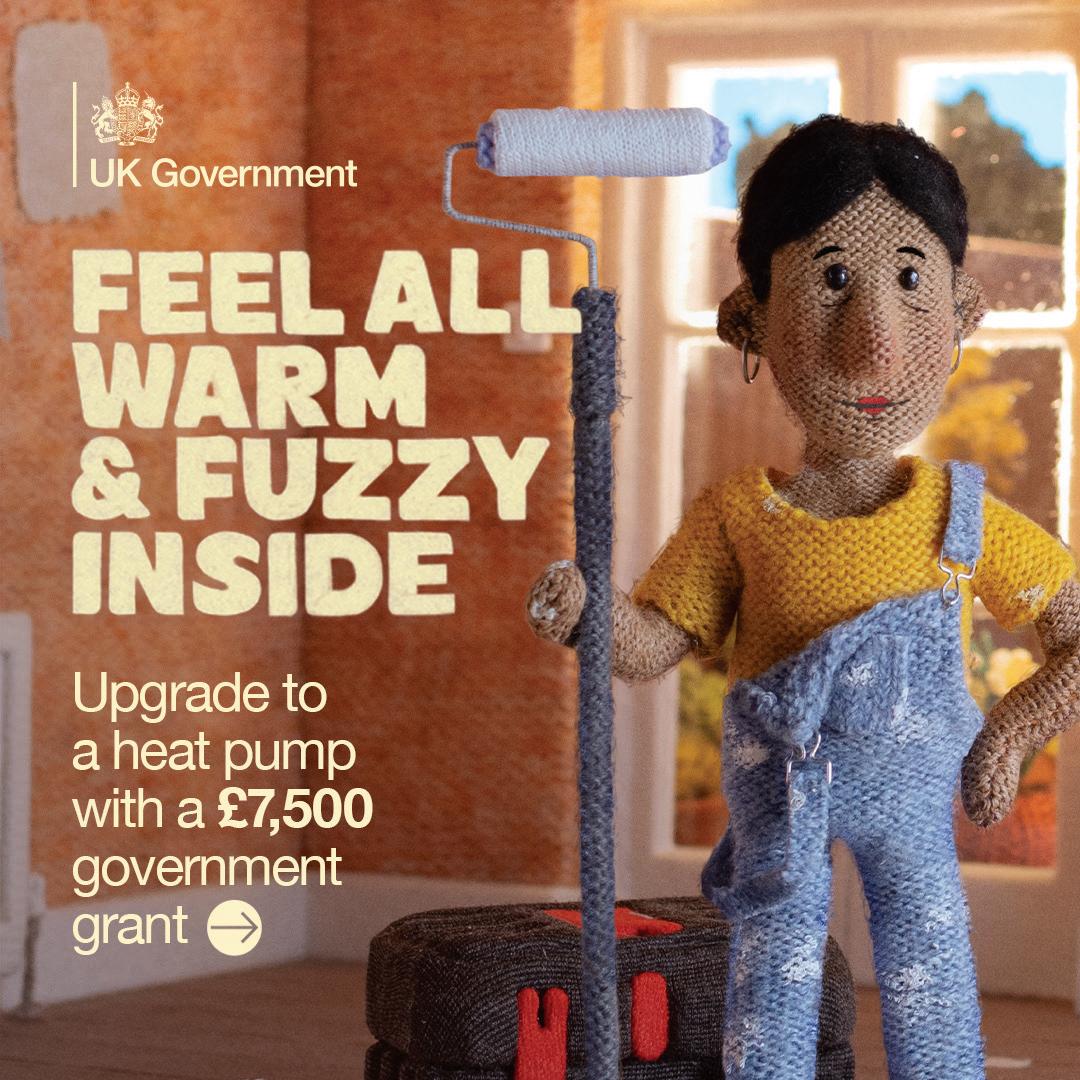
Warm and fuzzy
The government is promoting the benefits of heat pumps and the £7,500 BUS grant with a wide-ranging ad campaign.
The ‘warm and fuzzy’ TV ad features knitted characters filmed using stop-frame animation. The characters in their knitted homes share their own experiences of being happy heat pump homeowners, with the script based on real testimonials.
The campaign is on TV, video-on-demand, digital and social platforms as well as in the press and, in some areas, on EV charging points.
Note: The installation and servicing of heat pumps does not fall within Gas Safe Register’s remit or under the Gas Safety (Installation and Use) Regulations 1998.
effect in April, sets an obligation on bigger boiler manufacturers to sell a percentage of heat pumps in proportion to their boiler sales. In this first year of operation, they’ll need to reach a target of 6% or face ‘fines’. It’s thought that this first year of CHMM won’t cause too many headaches on that front, and that they are likely to reach their targets. Second-year targets have yet to be set.
On the up
The latest Boiler Upgrade Scheme figures continue to show a rising trajectory, despite a small dip in February, and the number of installations continues to increase. Figures from February 2025 show that more than 60,000 grant-funded heat pumps have been installed since the scheme opened.
The BUS originally opened in 2022 with £480 million of funding until 2025. Funding has been nearly doubled since then and the scheme length has been extended.
However, fewer than 9,000 heat pumps have been fitted in Scotland under grant schemes since 2019. The Scottish government has also announced that it has shelved its proposed Heat in Buildings Bill for now, which would have required gas boilers to be

“The latest Boiler Upgrade Scheme statistics show a rising trajectory.”
replaced with alternatives, such as electric heat pumps, within a set timeframe after the sale of a property.
Training
When it comes to qualified installers, 2024 saw 9,062 people complete a recognised heat pump training qualification – up 15% on the previous year, according to the Heat Pump Association.
HPA chief executive Charlotte Lee says: “Interest in the training is growing. However, there is a gap
Mind the spark gap
between the number of trained individuals and active heat pump installers working in the market, with around 39 per cent of those who complete a training course currently not going on to install heat pumps.”
It’s important to note that consumers can’t access grants such as the BUS unless their heat pumps are fitted by qualified MCS-accredited installers. In order to selfcertify, installers also need to be a member of a competent persons scheme – APHC, NICEIC, OFTEC or NAPIT. ■
A major barrier to wider take-up of heat pumps is energy pricing. The disparity in costs between electricity and gas, known as the ‘spark gap’, means that heat pump running costs under current electricity prices are not significantly lower than those of a gas boiler.
Servicing checklists now available
The Heat Pump Association has developed annual service checklists for different types of heat pumps. The checklists for air, ground and water-towater heat pumps outline the recommended minimum annual service checks for systems.
They’re designed to be a resource for situations where manufacturer-specific guidance on service and maintenance checks is not available. They are not intended to replace manufacturer guidelines but can be a useful reference point for reviewing how effectively heat pumps are operating.
Tony Lathey, chair of the HPA Technical Working Group, says: “These annual service checklists are the result of collaborative efforts from leading industry experts. They set a baseline for best practices, supporting installers in servicing and maintaining hydronic heat pumps effectively, in the absence of manufacturer-specific guidance.” www.heatpumps.org.uk/ resources/technical-resources/
Gen up on next-gen heating
Andy Smith, national sales manager at Grant UK, looks at the status quo in the heat pump sector.
New policies and innovation are changing the heat pump sector. One of the primary drivers of change is the Future Homes Standard, which will require developers, housebuilders and installers to move towards lowcarbon heating solutions. Air source heat pumps (ASHPs) are at the forefront of this transition. Increasing demand means that more qualified heat pump installers will be needed, making it an opportunistic time to diversify and upskill.
Environmental pressures and legislative changes are phasing out refrigerants with high global warming potential (GWP) figures, prompting manufacturers to move towards greener alternatives. R290 is becoming mainstream in heat pump systems: its GWP of 3 is significantly more eco-friendly than predecessors.
However, there are new challenges: unlike earlier refrigerants, R290 is classified as flammable, which means installation and servicing require
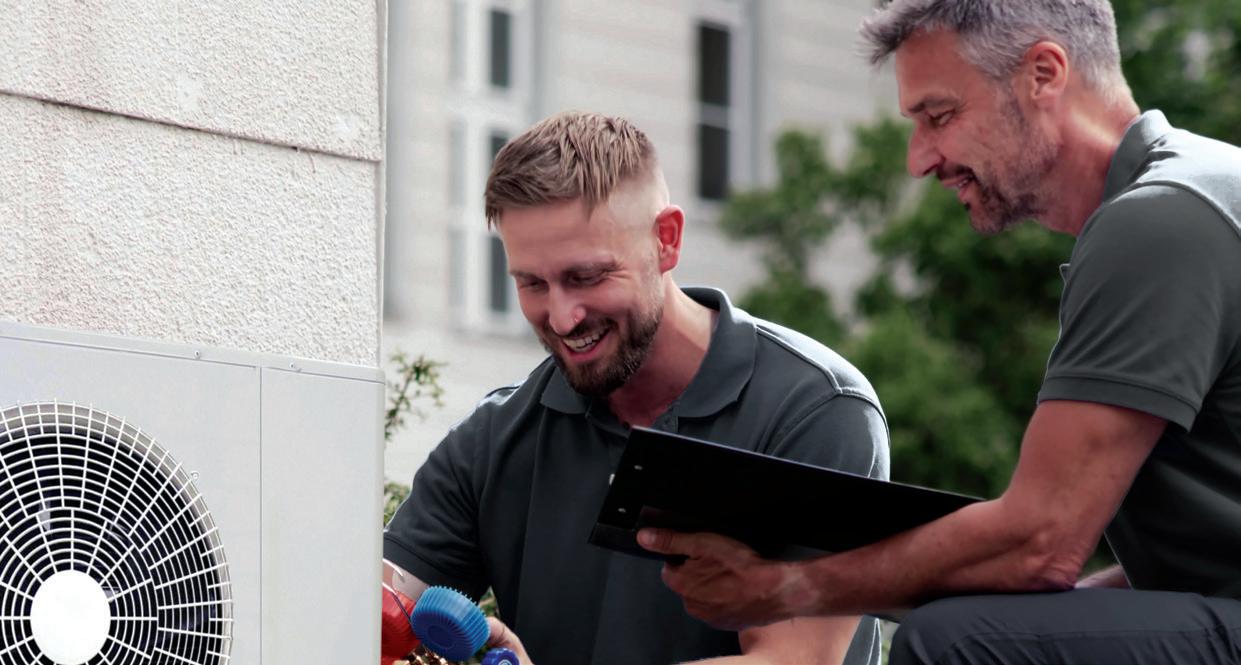
If you want to work in the renewable heating market, you need to know about certification. The Microgeneration Certification Scheme (MCS) provides product and contractor certification that installations meet recognised industry standards. MCS accreditation is mandatory for engineers who want to access government incentives such as the Boiler Upgrade Scheme. Installers can either become MCS-certified individually or work under an umbrella scheme that offers compliant oversight for each project.
heightened safety awareness
and additional training.
Heat pumps using R290 are designed with enhanced safety features including larger casings, vibration-minimising compressors, anti-leak technologies and built-in leak detection sensors.
Working with R290 calls for an understanding of best practices for safe handling, wiring requirements, commissioning procedures and protective zones. Installers must, for instance, allow for greater clearance around units
“Accurate heat-loss calculations are essential to size heat pumps correctly.”
to comply with safety standards. If you’re not familiar with the refrigerant, you’ll need to undertake specific training.
Calculations
There is a lot to consider at the installation stage too: Accurate heat-loss calculations are essential in order to size heat pumps correctly and match them with suitable heat emitters.
Positioning of the unit is equally important, both to ensure efficient operation and to comply with space requirements relative to adjacent properties. Installers must plan for an appropriate base for the outdoor unit and determine where the hot water cylinder will be located.
How they work
Don’t forget to inform homeowners about how heat pumps work. Heat pumps function at lower temperatures than traditional boilers and should not be switched off. Misuse or misunderstanding can lead to higher running costs and complaints, so it is essential to provide thorough handover.
Guidance on system settings and operating modes, as well as efficiency tips, can help customers get the most out of their new heating system. n www.grantuk.com


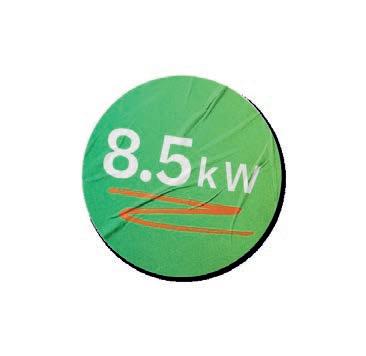
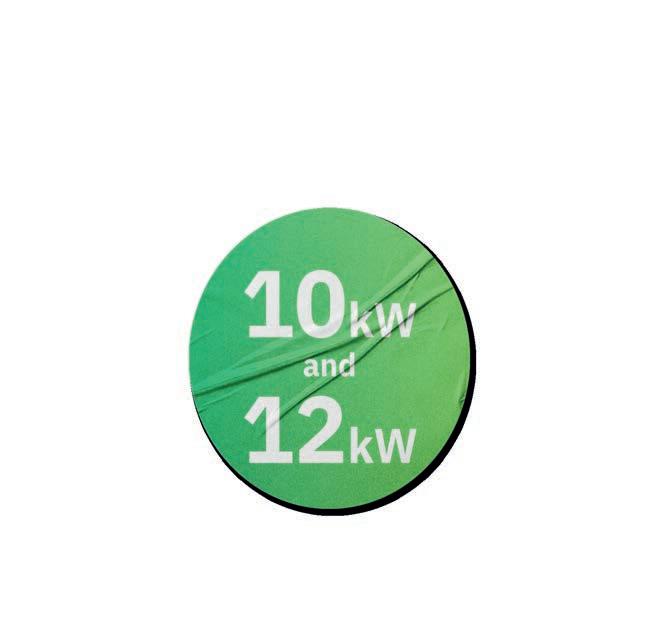
Certified for ultra-low noise levels
Our market-leading Ecodan R290 range just got bigger and better, offering even greater flexibility.
Capable of reaching high flow temperatures of up to 75°C, even as low as -15ºC outside.
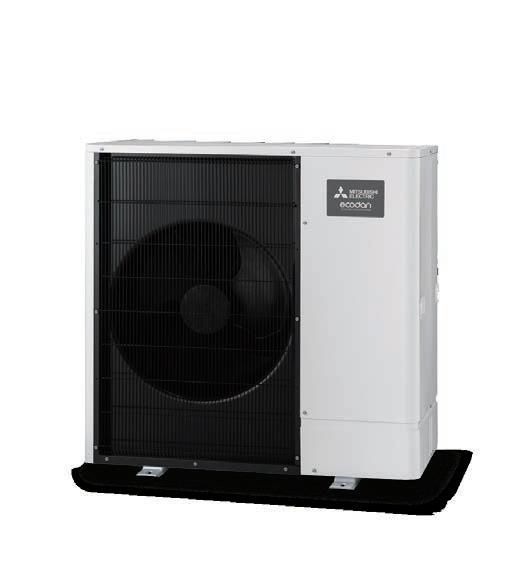
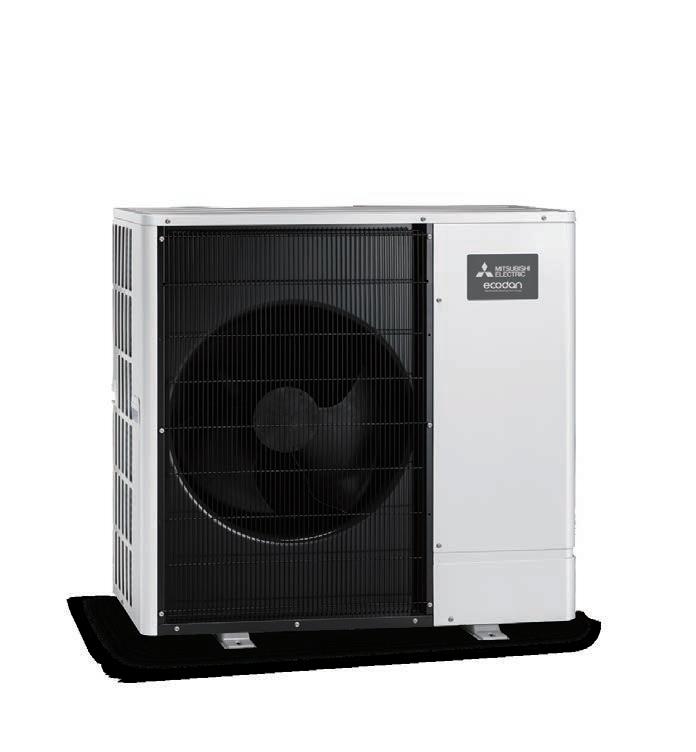
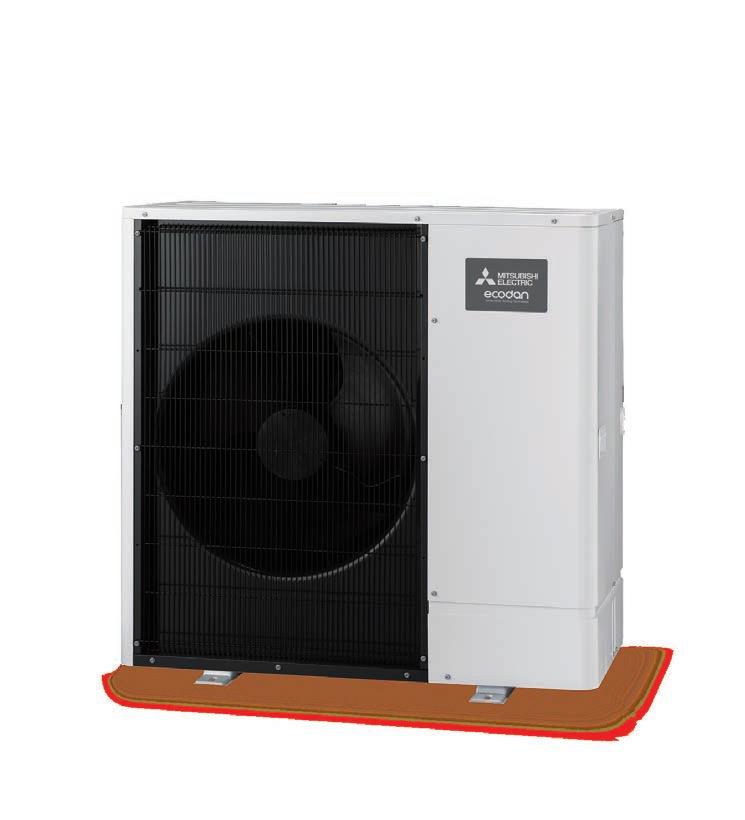
Tools that keep you safe
VDE insulated tools provide essential protection against electric shock while still providing precision and long-term reliability, says Jason Cunningham, product and technical support at Knipex.
Safety is paramount for all gas engineers and the tools you use play a crucial role in ensuring both efficiency and protection. VDE insulated tools are specially designed to protect users from shocks when working near live electrical components.
The term ‘VDE’ comes from the German Association for Electrical, Electronic & Information Technologies, which sets rigorous electrical safety standards. These tools undergo thorough testing, including voltage insulation tests of up
against electrical current.
This protection is particularly relevant in heat pump installation, where systems require not only plumbing and refrigerant work but also electrical connections, from wiring control panels to installing power supplies.
Installation often involves running electrical cables from the consumer unit, connecting sensors and wiring up the system’s control panel. Using VDE screwdrivers for terminal connections, pliers for gripping and cutting cables and wire
“VDE insulated tools provide a protective barrier against electrical current.”
to 10,000 volts, to ensure they provide protection up to 1,000 volts in live working conditions.
Heating systems increasingly integrate electronic controls, sensors and wiring, which means gas engineers can be working in close proximity to electrical components, where using standard tools could be hazardous. For example, if a spanner or screwdriver comes into contact with a live wire, it can result in serious injury or even fatal electrocution. VDE insulated tools eliminate this risk by providing a protective barrier
strippers ensures that these jobs can be carried out safely.
Of course, there may also be electrical work involved when servicing boilers. Many include electronic ignition systems, smart thermostats and integrated circuit boards.
Direct electrical work should always be performed by a qualified electrician when required but gas engineers may need to check or replace components that involve electrical connections.
One useful tool is a pair of VDE combination pliers.
These provide a strong grip on cables and can be used for cutting and stripping wires safely. Their insulated handles prevent electrical conductivity, making them ideal for working on control panels and terminal connections.
Clean cut
A VDE cable cutter is designed to cut through electrical wiring cleanly without causing damage to the strands. A sharp, precision-cutting edge ensures that cables remain in excellent condition for secure connections. VDE insulated screwdrivers are also indispensable for working on consumer units and control terminals.
For gas engineers considering investing in VDE tools, make sure you choose those that are properly certified. Tools should carry the VDE certification mark, along with compliance to the IEC 60900 standard, which confirms they have passed all necessary safety tests. www.knipex. com
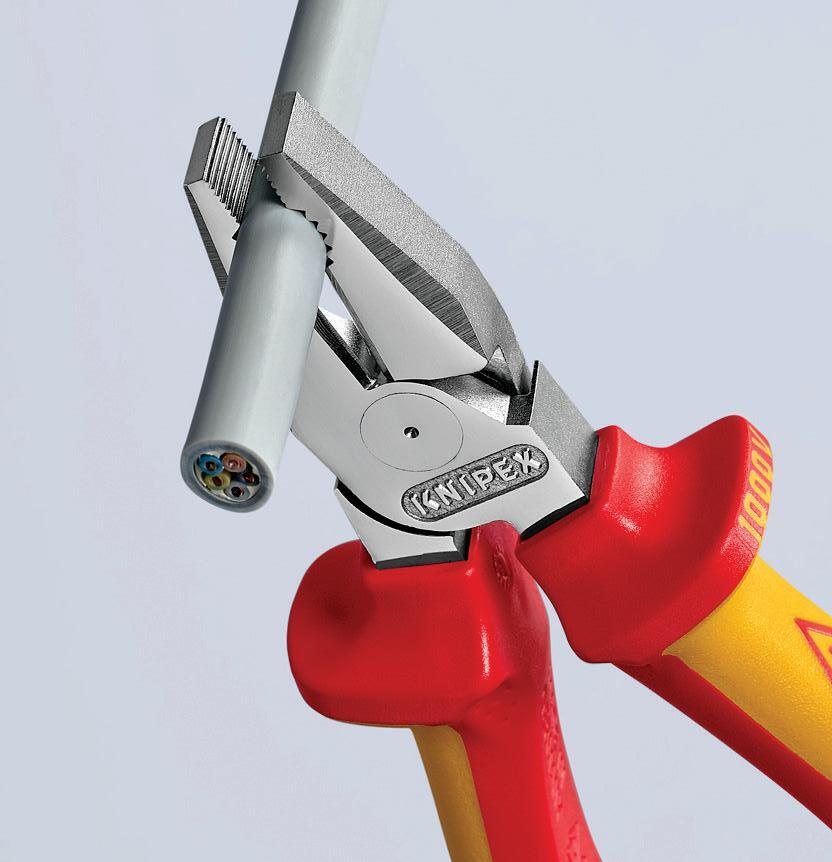
Accessible training is key
Innovative training delivery models are preparing heating engineers for a changing industry, writes GTEC’s Griff Thomas.
If the heating industry is going to meet the net zero challenge, we need to push the boundaries of what training looks like.
We need to create bespoke, specialist training opportunities that cater to all installers, from new entrants to experienced gas engineers looking to upskill. Teaching theory in a classroom does not provide the confidence to design and install complex heating systems in real homes.
Professional development needs to be integrated into working lives, including manufacturer-led courses and merchant partnerships, product training and purposebuilt showrooms that combine the latest technologies with improved practical experiences.
Accessibility coupled with different learning options will engage installers and help them develop skills and confidence in low-carbon heating.
Train on the spot
Merchants and manufacturers can deliver valuable training at the places where installers spend their time. These trusted partners understand the real challenges faced on jobs and can provide impartial advice and hands-on training with the equipment engineers will be installing.
Similarly, manufacturer
“Training shouldn’t just be about ticking boxes.”
training provides significant advantages. Engineers can access the latest technology and innovations, gain insight into features and troubleshooting and get support from technical experts.
For engineers transitioning to low-carbon technologies, realistic preparation is a way to face and overcome realworld problems in a supported environment, building confidence to take on complex heating systems.
Flexible delivery
Training providers have practical solutions to fit around installers’ working lives. Digital modules are great for CPD or regulatory updates and
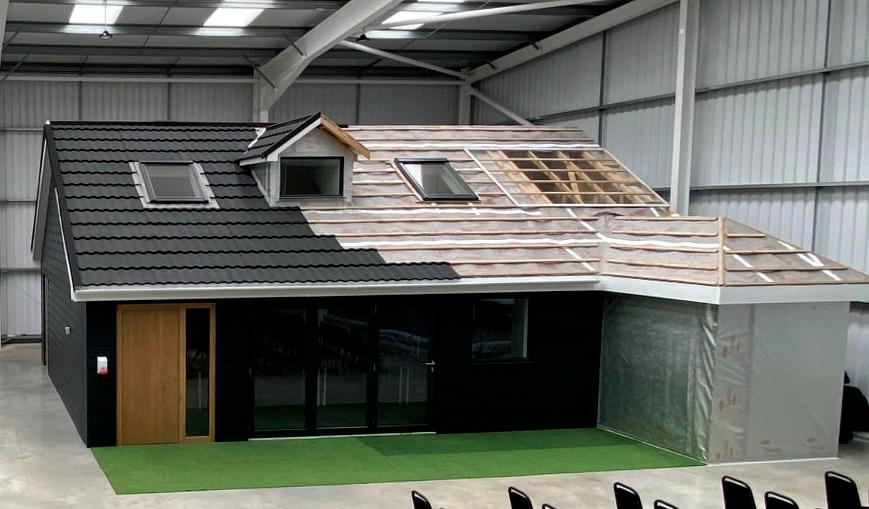
GTEC’s Building Performance Hub in High Wycombe includes a full-size domestic setting where engineers can tackle real installation challenges on the in-centre bungalow, from navigating tight spaces to routing pipework through actual walls and positioning equipment in authentic plant rooms
“Realistic preparation is a way to face and overcome real-world problems.”
provide on-demand support for in-centre learning. Flexible and accessible upskilling removes some of the barriers that have traditionally prevented experienced installers from embracing new technologies.
As the industry continues to evolve, those who embrace these new training methods will be best positioned to thrive in the growing low-carbon heating market. The question is no longer whether to upskill: it’s how to choose training that prepares you for the installations of the future.
Preparing for the road ahead
The transition to low-carbon
heating presents both challenges and opportunities for gas engineers. Reimagining how training is delivered, making it accessible, practical and relevant, will give them the knowledge and skills to meet the changing needs of their customers.
Training shouldn’t be just about ticking boxes. It needs to result in confident and capable installers who can deliver highquality heating systems in real homes.
The future depends on skilled hands and modern training is putting those skills within easy reach. n https://gtec.co.uk/
Power up your online business with AI
Generative AI is changing how businesses market themselves online, providing affordable ways to reach more people and save time, writes Harry Budd, marketing manager at Logic4training.
Artificial intelligence (AI) isn’t new but developments in generative AI have made it accessible and free to use for everyone, including small businesses. It won’t replace your technical knowledge or customer service skills but it can reduce the time you spend on marketing tasks.
Here are three practical ways AI can become your digital marketing assistant.
1. Improve your website First impressions count: your website is often the first interaction that potential customers have with your business.
Free AI tools, such as Chat GPT or Claude AI can analyse your website and give actionable tips to improve search engine optimisation (SEO) and performance.
Top tip: The way you ‘talk’ to AI matters. The process is known as prompt engineering. For best results, be specific and ask clear questions. For example, “How can I improve
“Use AI to draft blog posts, FAQs or case studies that highlight your expertise.”
the local SEO for my UK plumbing business?” is more effective than simply asking for SEO tips.
2. Create quality blogs and service pages Regular, high-quality content such as blog posts, FAQs and service descriptions not only improves SEO but establishes industry expertise.
Writing content might not be top of your agenda but AI tools can give you a solid starting point. Remember to tweak the suggested content with your own knowledge and experience to retain your unique voice.
• Use AI to draft blog posts, FAQs or case studies that highlight your expertise in gas safety.

• Incorporate trending keywords and relevant topics such as safety inspections and seasonal maintenance tips. Remember, AI can help you identify keywords.
Top tip: Be explicit with your instructions and specify your location and target audience.
3. Keep your social media engaging Maintaining an active, consistent social media presence online helps to build trust. For those uninspired moments, Gen AI tools can help you generate ideas that educate and engage your audience and even manage your content with automated post scheduling.
For example: “Generate five engaging social media post ideas for a Gas Safe engineering business.”
You are the expert Integrating free AI tools into your marketing strategy can help improve your online presence: but they do have limitations. Gen AI should enhance your expertise rather than replace it, so make sure you review and personalise generated content. Even advanced models require human eyes to verify accuracy, so always check the facts. n
Logic4training’s new guide ‘How to use AI for your plumbing & heating business’ is available free at: www. logic4training. co.uk/insights/ how-to-useai-for-yourplumbingheatingbusiness/
We have the UK’s widest range of underfloor heating systems. Combine this with our expert sales advisers, and you can see why Continal always provides the best solutions.
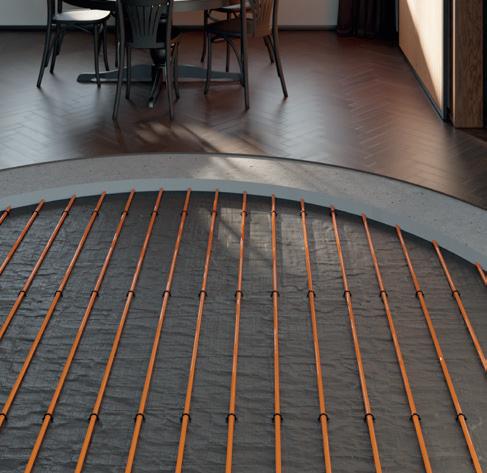
We design all our systems to work with any heat source, floor construction and covering. Whatever your project we have the solution.
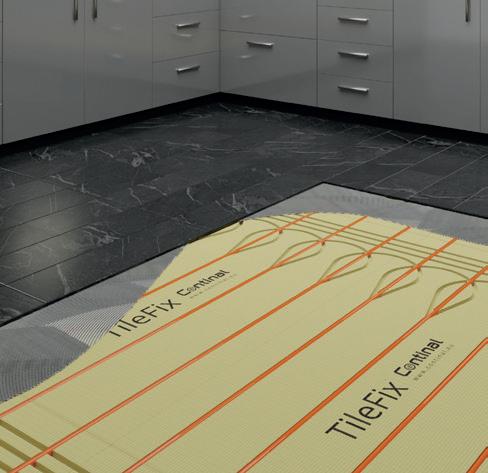
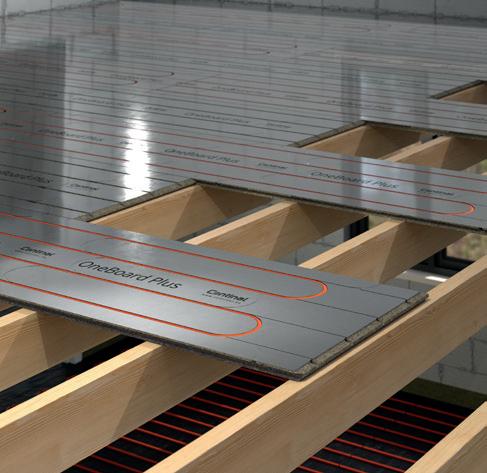

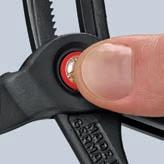
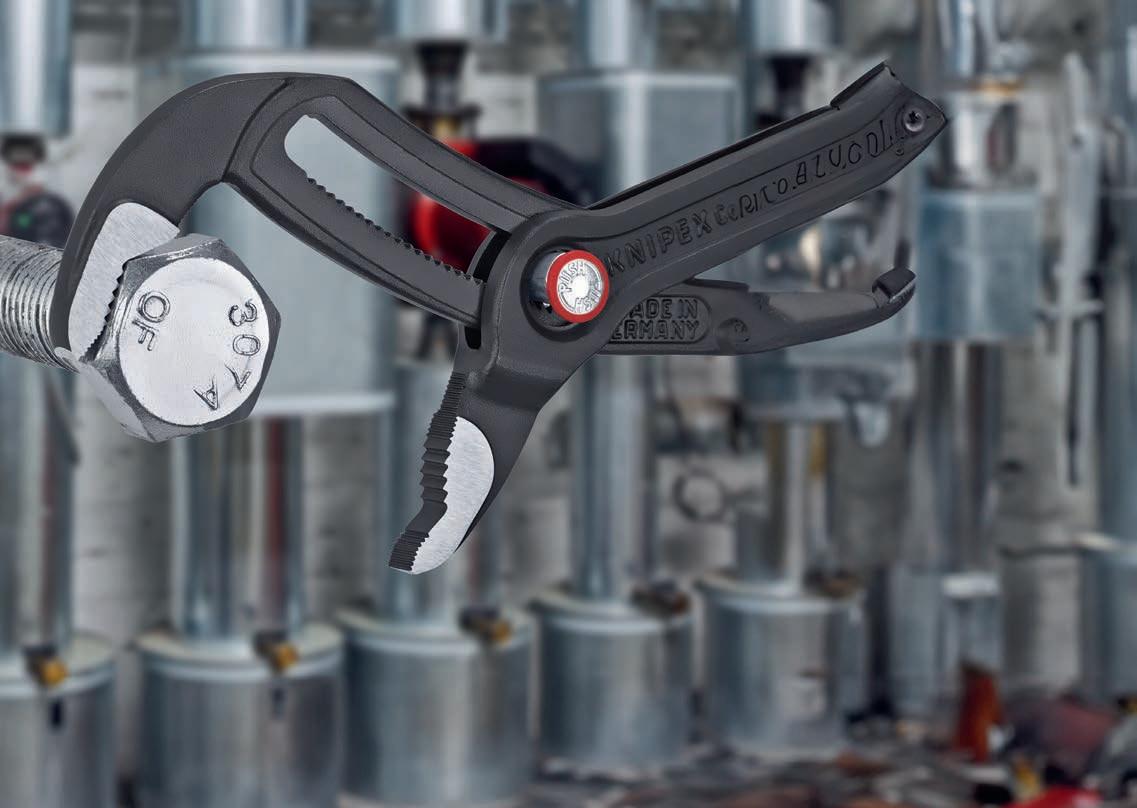


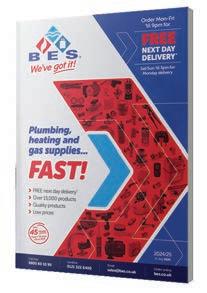
Energy Secretary unveils Vaillant cylinder plant
Energy Secretary Ed Miliband has visited Vaillant’s new manufacturing plant to see it produce its high-recovery hot water cylinders.
The multi-million pound investment underlines the company’s commitment to the innovation and progression of low-carbon home heating systems, it says.
The dedicated facility in Derby, near Vaillant’s Belper HQ, will manufacture its new Unistor high-recovery slimline cylinder models. The cylinders have been developed to meet the need for low-carbon, lowtemperature heating systems as well as traditional boiler systems.
The Energy Secretary also spoke with apprentices new to the industry and based at the manufacturing plant, who are either college based or joining Vaillant from the betterWeld organisation, which helps train and place those out of work.
Ed Miliband said: “The clean energy transition is the economic opportunity of the 21st century. This government
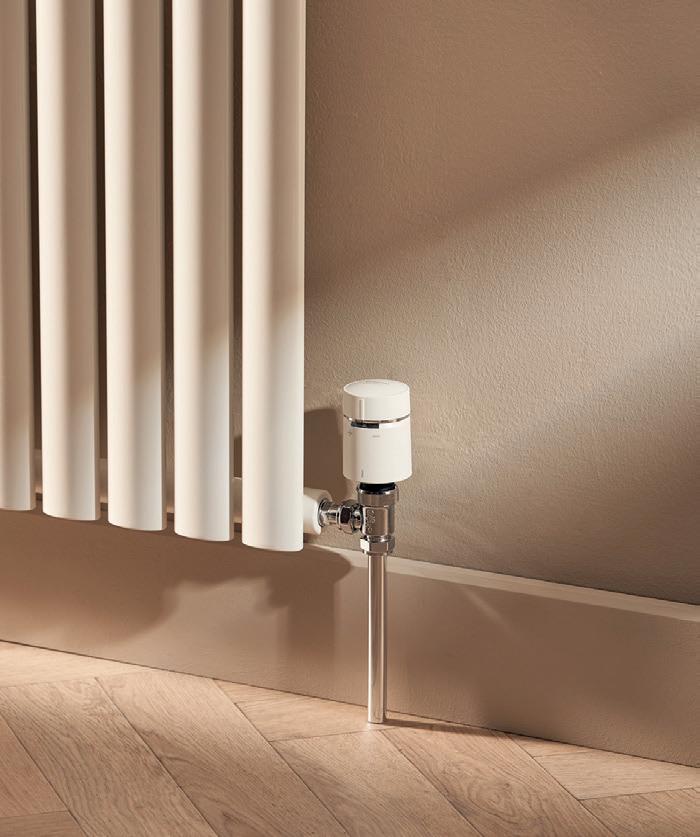
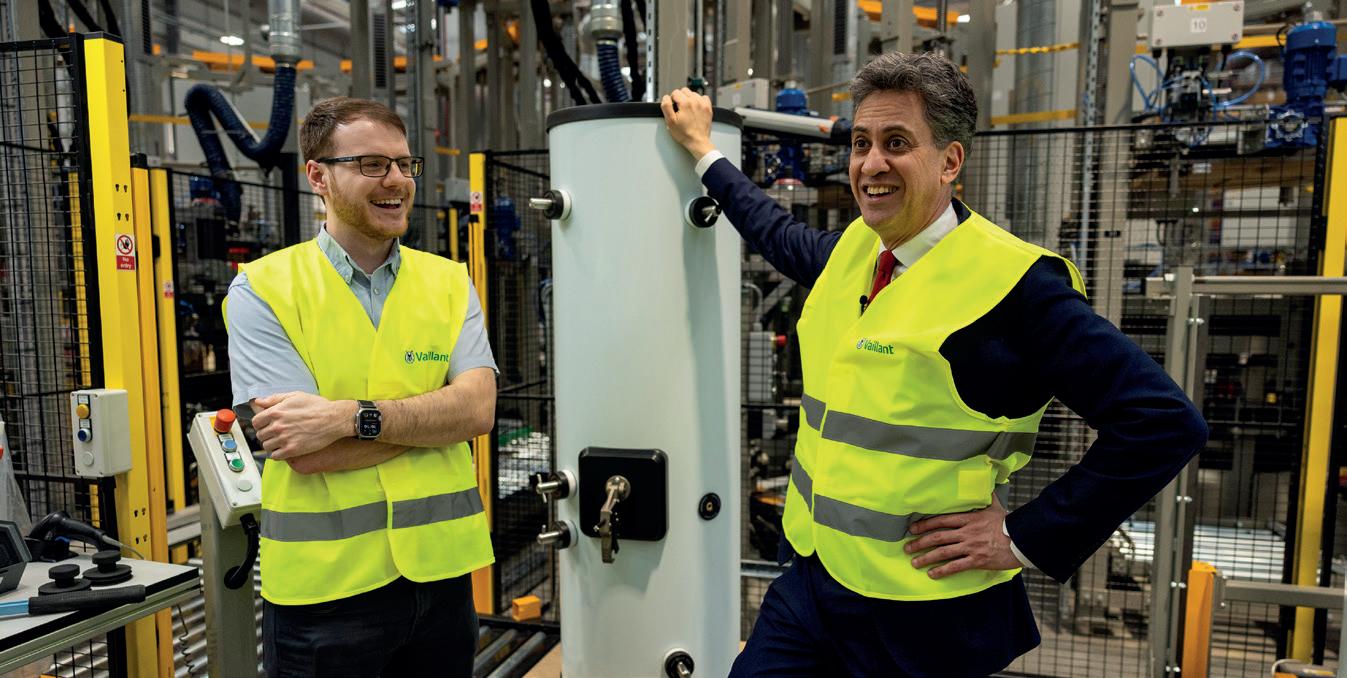
intends to seize the chance for Britain to lead.
“What this new Vaillant plant shows is the different economic opportunities we can get from becoming a clean energy superpower. By building heat pumps in Britain and continuing their roll-out, we can not only ensure people have warmer, lower-carbon homes but support jobs like these in Derby.”
Henrik Hansen, managing director of Vaillant Group, UK and Ireland, added: “By investing in the production of
advanced, energy-efficient hot water cylinders, we’re providing a full heat pump system solution to support the overall development of the UK supply chain, ensuring products are designed and manufactured to meet the needs of the country’s housing stock.
“With a heritage in the Derbyshire region that dates back to 1934, we are proud to be part of a region which has a wealth of manufacturing innovation and expertise across a wide range of industries.”
What really matters on heating controls
When it comes to smart heating controls, what do your customers really want?
According to a Drayton survey, it’s heating that can be managed via a smartphone app (66%) and a system that provides room-by-room heating control (50%).
High energy costs mean that energy-saving features such as smart modes were a close third (48%), followed by the flexibility to add further connected devices later.
According to the survey,
the most common issue that causes delays on the job is products that are hard to install (64%). Alongside this, product compatibility issues were another cause of wasted time, cited by 44% of installers.
Merlin Milner, product owner for water-based systems at Drayton, said: “The results of our research highlight that in today’s market, customers are prioritising simplicity and convenience; they want the ability to control their heating remotely via a user-friendly app
on their mobile and ways to improve efficiency. As such, it’s crucial that tradespeople have a go-to solution they can trust to deliver all these key features and doesn’t cause them delays when working.
“The Wiser solution is a one-stop solution for installers, that offers all of this and more. Wiser is capable of controlling a wide range of heating systems and is easily scalable as additional devices can be added to the system at any time.”
DAB debuts ‘plug and play’ Evoplus Lite circulator
The Evoplus Lite is an advanced wet rotor electronic circulator designed to enhance efficiency, reliability and comfort in residential and commercial heating, cooling and domestic hot water.
Plug-and-play installation and the quick-connect power supply make wiring fast and hassle-free, reducing installation time, says DAB Pumps
Evolite Plus is suitable for large residential buildings, apartment blocks, offices, schools, hospitals and commercial properties, providing adaptive, high-
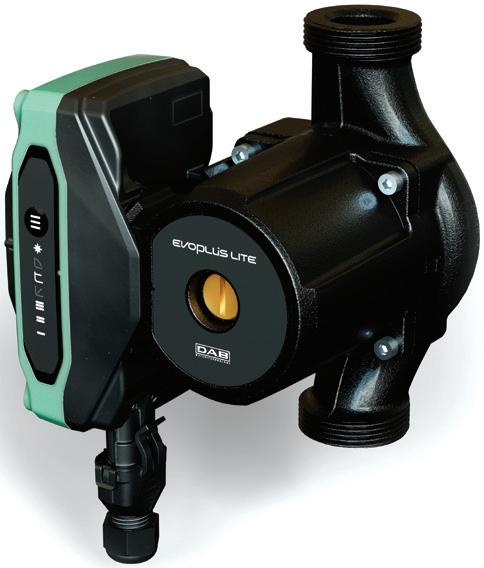
efficiency performance while minimising energy consumption and operating costs. Its sensorless motor control optimises performance so that energy is used only when needed.
The circulator operates in heating and cooling systems. It adjusts to fluctuating demand, preventing energy waste and maintaining stable operation in airconditioning systems. www.dabpumps.com
Rinnai adds unvented water heaters

Rinnai is introducing a range of unvented water heaters to its cylinders. The units use Venturi technology to minimise expansion, ensuring low ongoing maintenance and optimal performance, says the company.
They are built of Duplex stainless steel, for long-term reliability, and their user-friendly design makes installation straightforward, it adds.
Safety features include a factory-fitted 7bar/90ºC pressure and temperature relief valve.
The range is available in capacities from 80 litres to 500 litres and in the following model types: built-in expansion, solar, slimline, super Slimline, horizontal, heat hump and heat pump 28. www.rinnai-uk.co.uk/ products/electric-storage-hotwater-solutions
10-year warranty on Evomax 2 boiler
Evomax 2, the wall-mounted boiler from Ideal Heating Commercial, now comes with a 10-year warranty.
The warranty covers parts and labour when Evomax 2 is installed on an Ideal Heating pipework header kit with plate heat exchanger and commissioned by Ideal Heating Commercial. Commissioning is provided as a free service.
An enhanced appliance and primary system check, at £250 per boiler, is also required under the terms and conditions of the 10-year warranty.
The existing five-year warranty is still available with free commissioning.
The Evomax 2 is the UK’s best-selling wall-mounted boiler, says Ideal Commercial. It is available with outputs from 30kW to 150kW, which can be increased to 900kW in cascade. idealcommercialheating.com
Simple integration with Navien PEM750
Navien’s upcoming PEM750 heat pump is designed to integrate into any environment, whether new build or retrofit. The company says it’s a high-performance, eco-friendly heating and hot water solution with quick, easy installation.
The PEM750 can supply up to a maximum temperature of 75°C and operates down to -20°C. It has an ERP rating of A***, a Seasonal Coefficient of Performance (SCOP) of up to 4.87 and uses R290 refrigerant.
Technical director Sean Keleher says: “We are delivering an innovative high-performance heat pump that is simple to install, highly efficient and fully supported by training and Navien’s expertise.
“Our goal is to make the transition to renewable heating as seamless as possible for installers and their customers, and this latest innovation joins our existing range of products designed with hot water delivery and comfort in mind.”
The digital touchscreen controller and smart app enable users to monitor power usage, adjust settings and access fault codes. https://navien.co.uk/ register-interest/
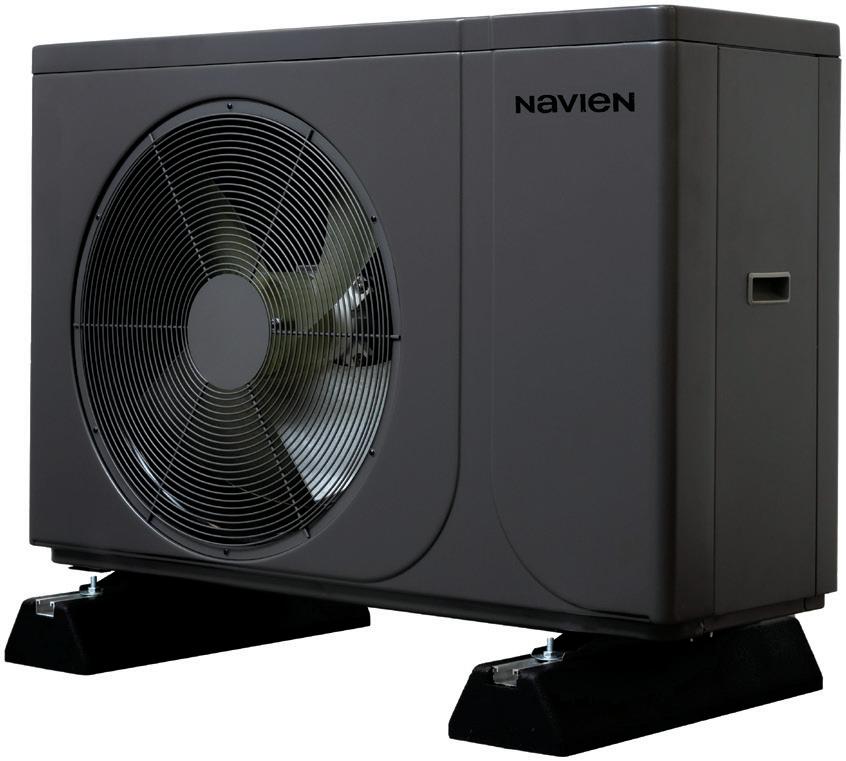
Stay up to date at: www.registered gasengineer.co.uk
Slimline high-recovery cylinders from Vaillant
Vaillant has revealed its new high-recovery, slimline Unistor cylinder range and a buffer that can be integrated with it.
The cylinders are available in a range of slimline sizes – 90, 150, 175 and 210 litres –and come in both easy-to-install, pre-plumbed and traditional models to deliver efficient hot water for heat pump and boiler heating systems.
For customers who are not moving to a heat pump immediately, fitting the Unistor now means they will be able
change in the future if required.
When the complementary purpose-built buffer is fitted with a heat pump, it provides hydraulic decoupling, stores an additional heating capacity to use during peak demand and improves the overall performance of the system.
It can be fitted at the top or the bottom of cylinder, giving greater install flexibility and a neat finish, especially where space is limited.
https://professional.vaillant. co.uk/for-installers/products/ cylinders/
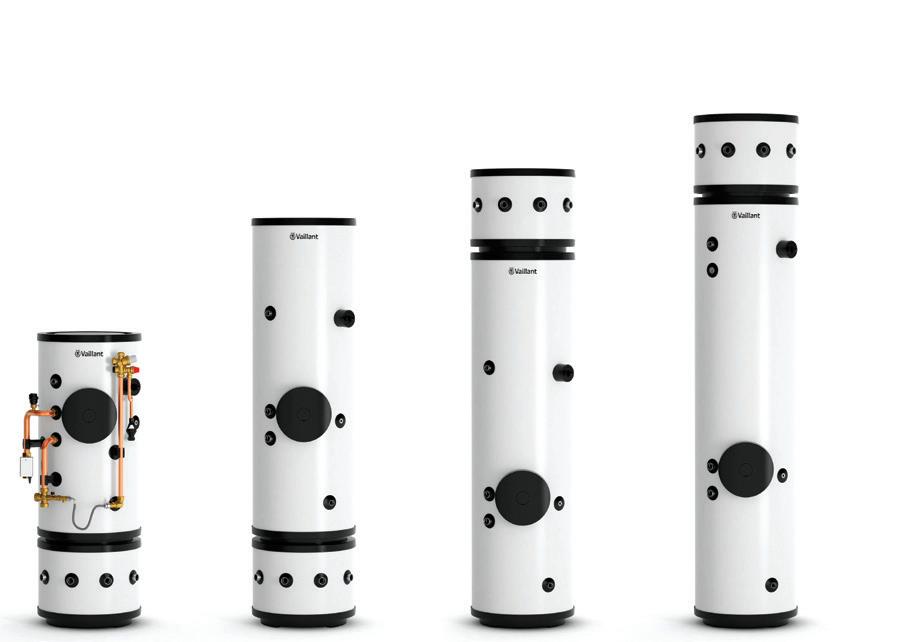
Small and easy to install: Vitodens 025-W
Viessmann Climate Solutions UK has added the compact combi Vitodens 025-W to its range. It comes in 24kW and 28kW outputs and with two years’ warranty as standard, extended to five years for installations registered on the Viessmann installer portal, as well as a 10-year heat exchanger warranty.
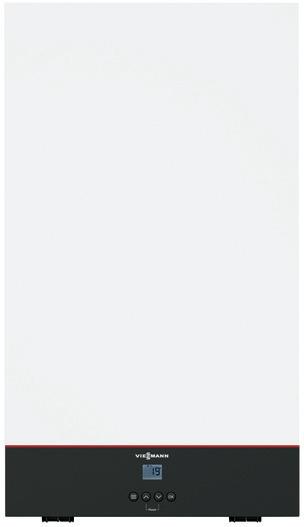
The wall-mounted gas condensing combi boiler has an integral instantaneous water heater and is ideal for living areas with limited space due to its low operating noise and small size (300mm x 400mm x 700mm).
The pre-commissioned unit is quick and easy to install and maintain, says Viessmann, adding that it has been designed with the housing specification market in mind. All components and connections are accessible from the front, which means no side clearance is needed. www.viessmann.co.uk
Mitsubishi Electric grows Ecodan R290 range
Mitsubishi Electric is expanding its Ecodan R290 heat pump range. The 5kW and 6kW models are being joined by 8.5kW, 10kW and 12kW heat pumps for larger homes and properties with a higher heat loss.
The new models provide flow temperatures up to 75°C, making them suitable for properties that cannot undergo extensive fabric upgrades or insulation improvements. They are compatible with existing microbore pipework so that owners can transition to renewable heating without major system overhauls.
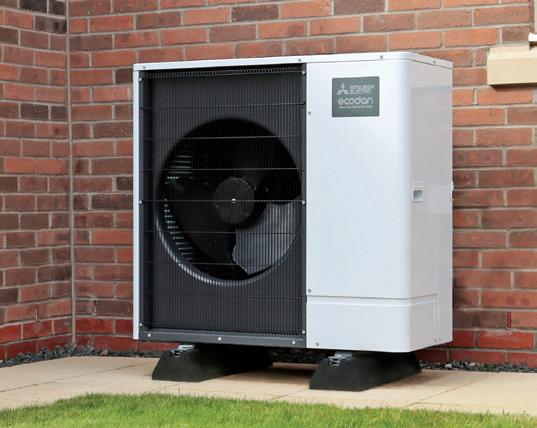
The Ecodan R290 heat pump uses the natural refrigerant R290 and its low-noise operation has Quiet Mark accreditation. The range is compatible with all Ecodan cylinders. https://les.mitsubishielectric. co.uk/
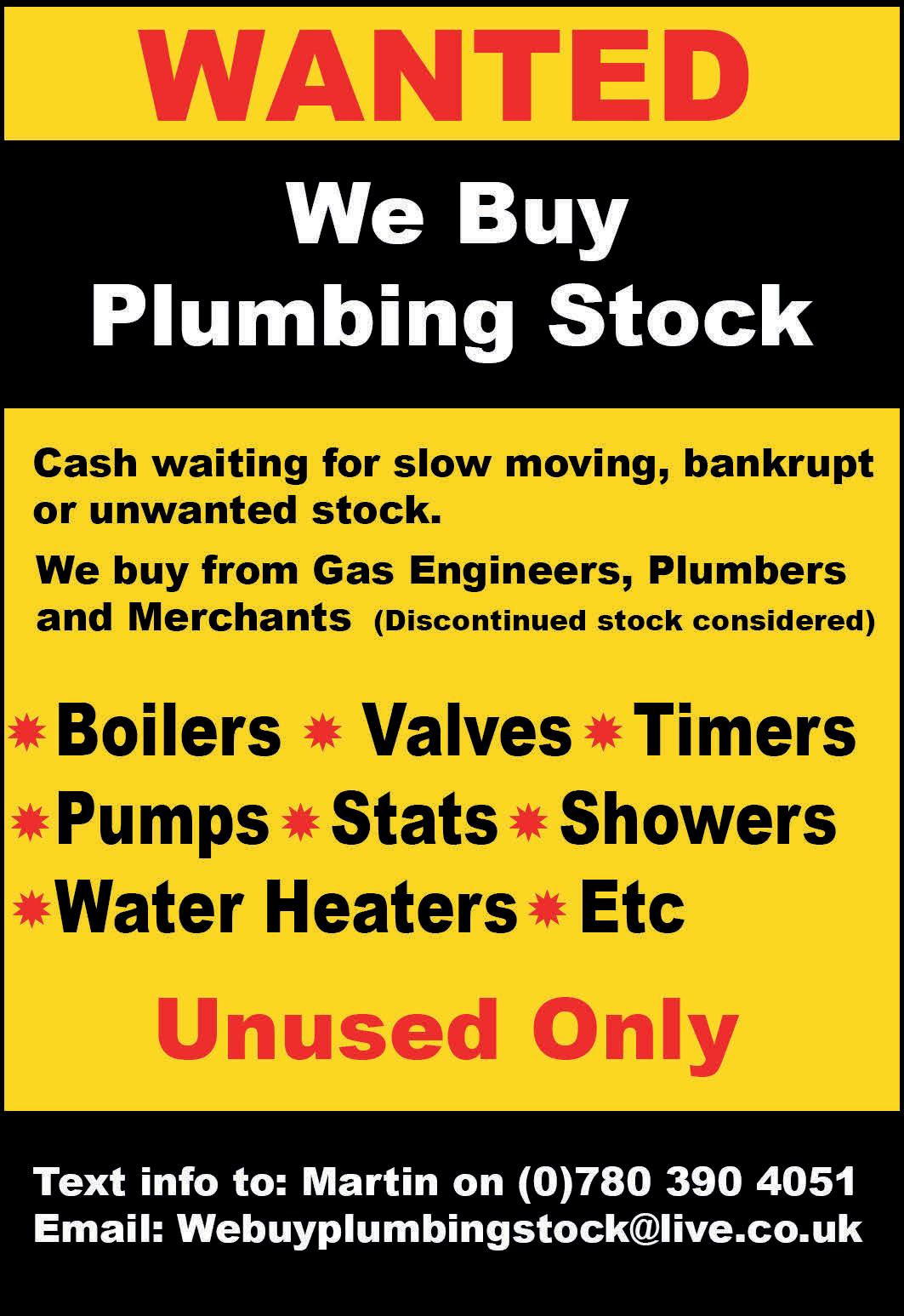

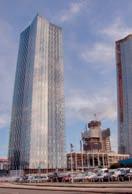


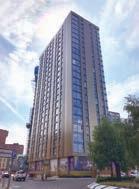



The ideal candidate must hold CCN1 and CKR1 elements, a CSCS card, and a full clean UK driving license. Ownership of the necessary tools is essential. You must also be dedicated to maintaining high standards of customer satisfaction and supporting the PJH company goals. If you are interested in finding out more about this exciting opportunity, please get in touch with Mark Tirrell, PJH National Installations Manager, by emailing on mtirrell@pjh.uk
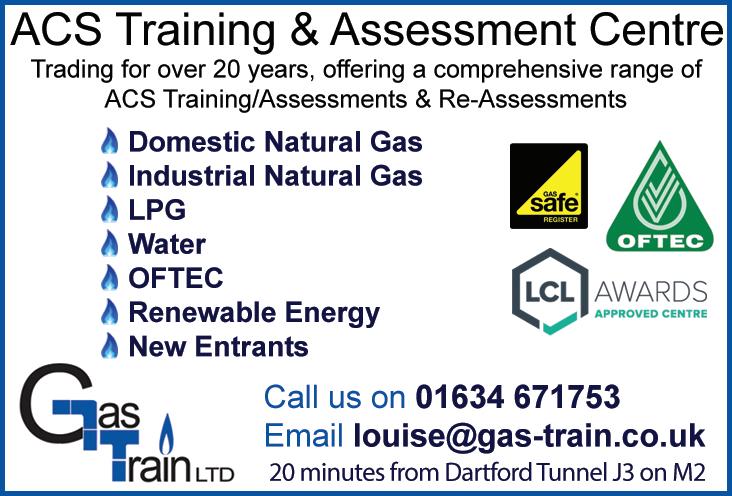
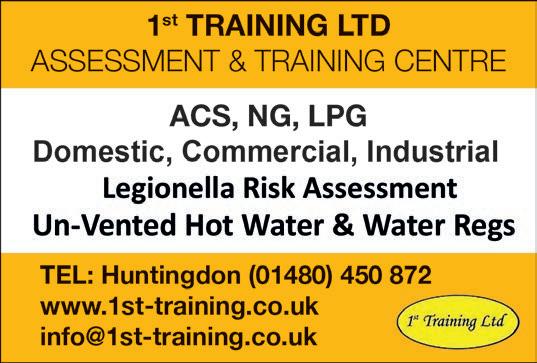


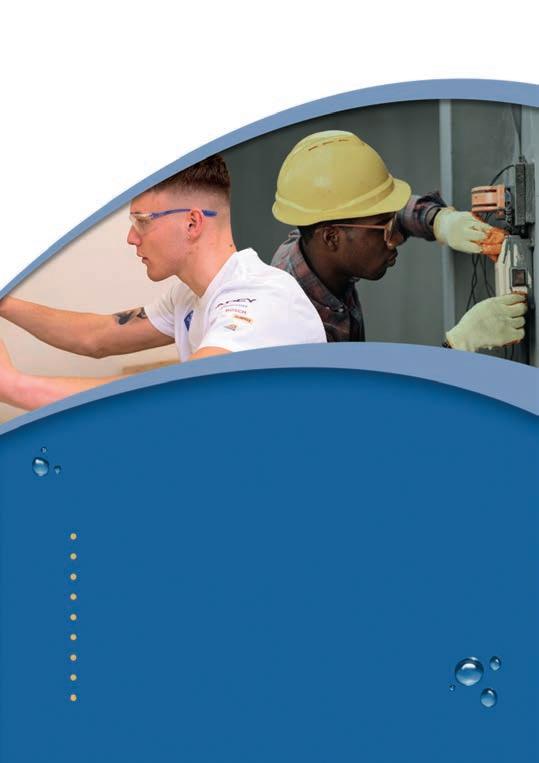

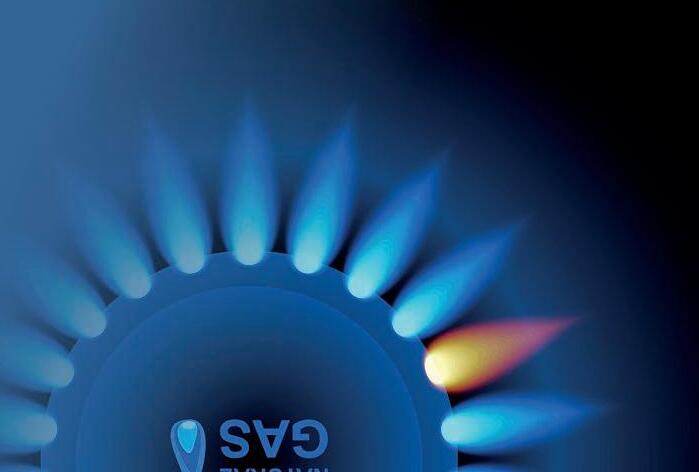




· All ACS Domestic Gas – core + appliances
·All ACS Commercial Gas including CMDDA1 and BMP1
· Unvented Hot Water & Water Regs
· Highly
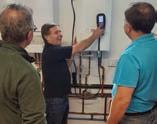
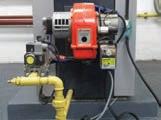
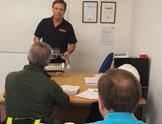




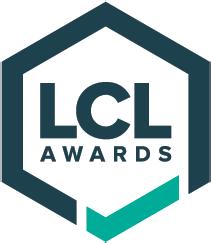
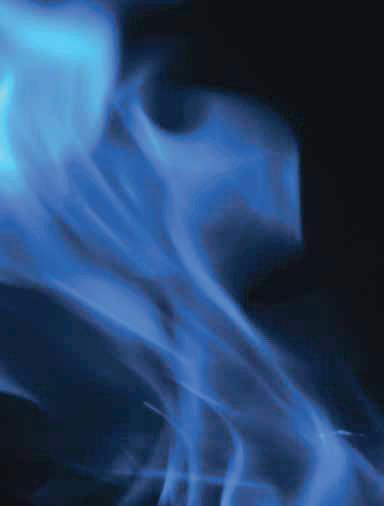

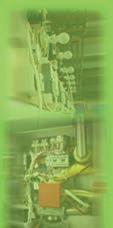










SOUTH WEST
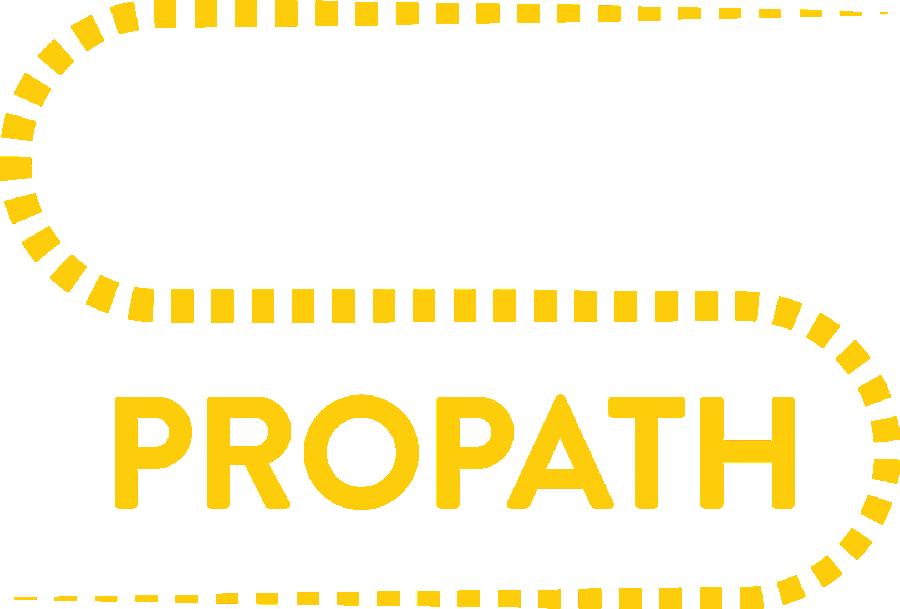
The new installer loyalty programme dedicated to growing your business
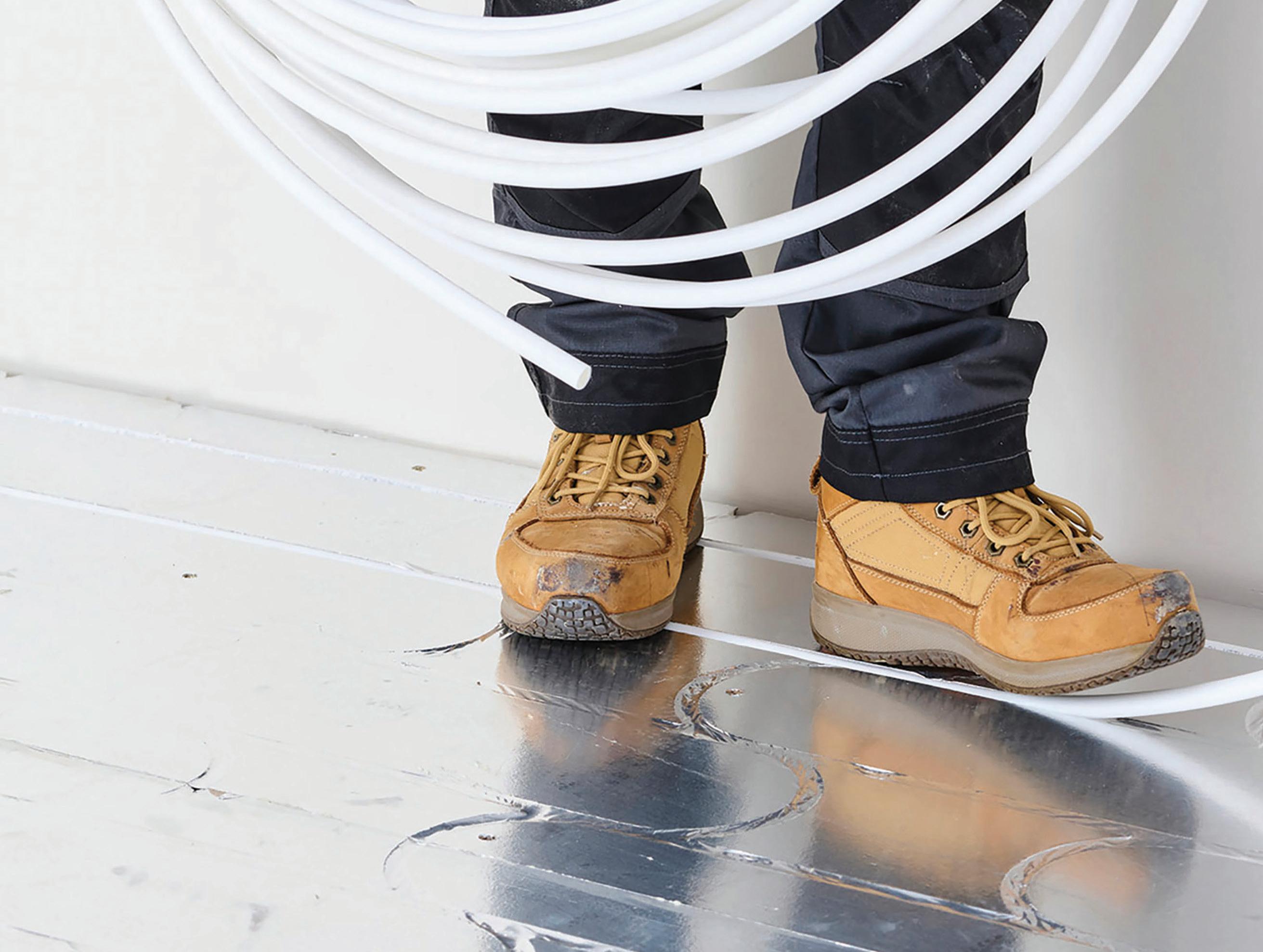
Exclusive discounts of up to 25% off UFH and 10% off heat pumps
Access to hundreds of homeowner and repeat business referrals to grow your business
Expert support from specification through to commissioning
